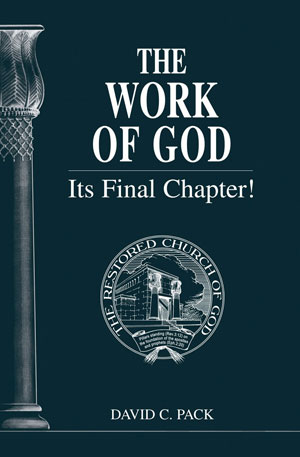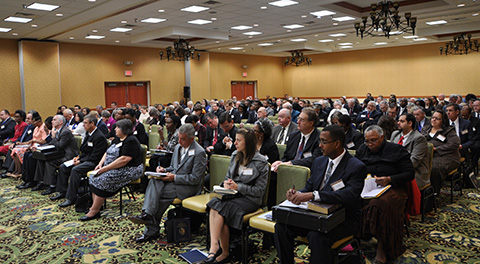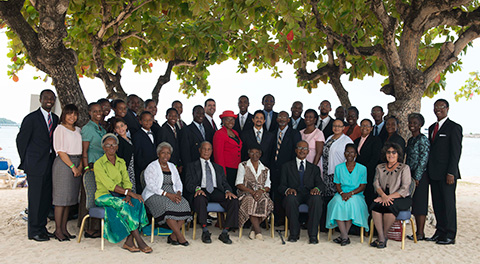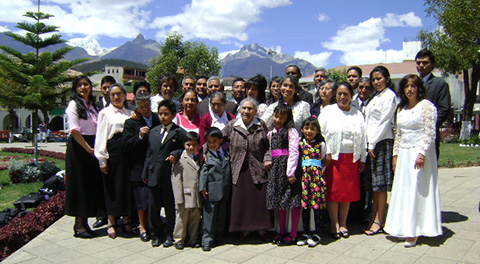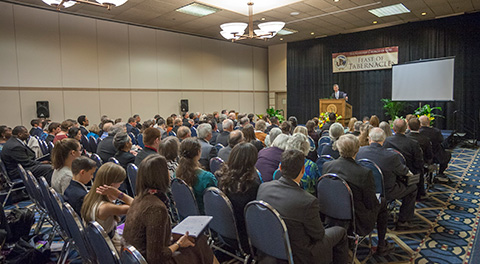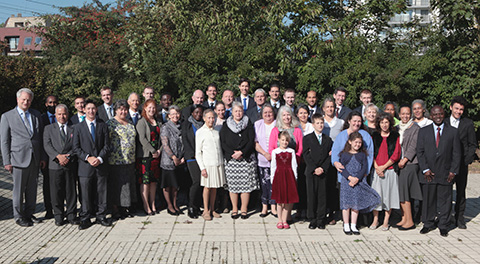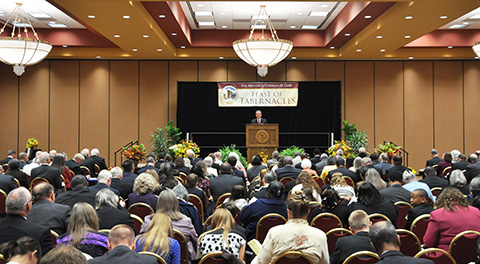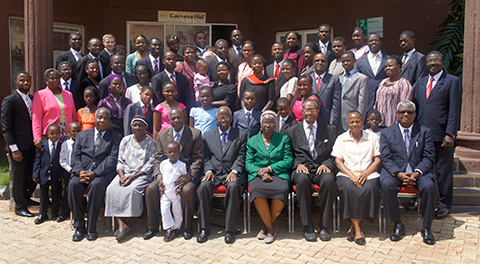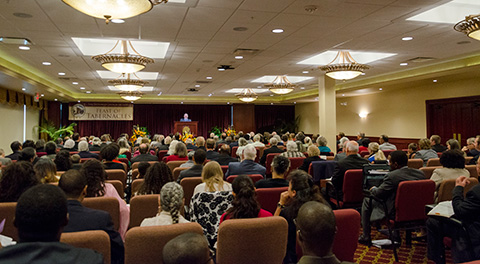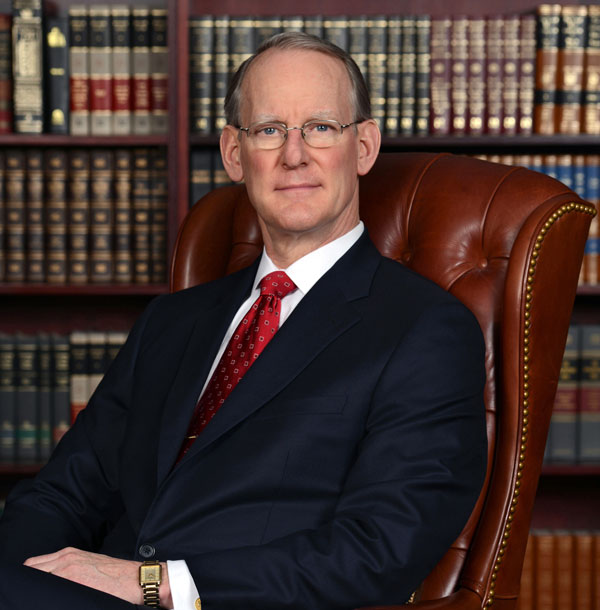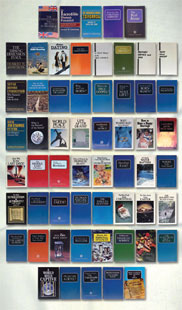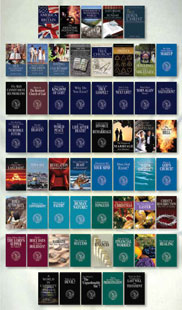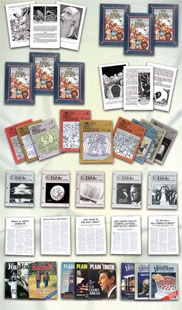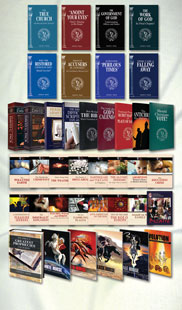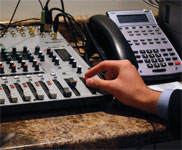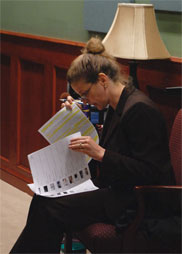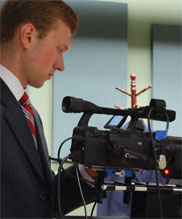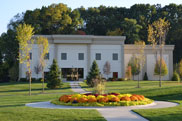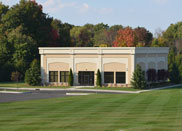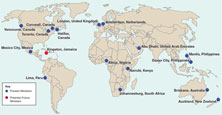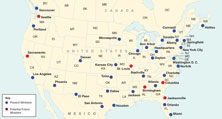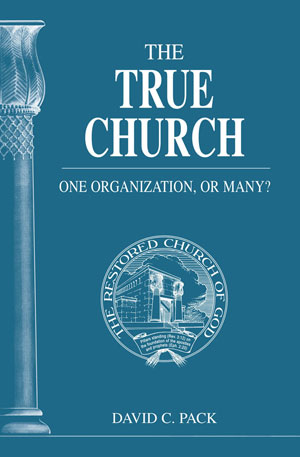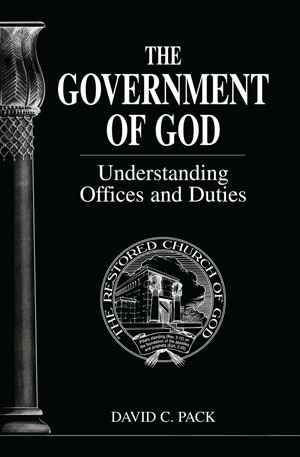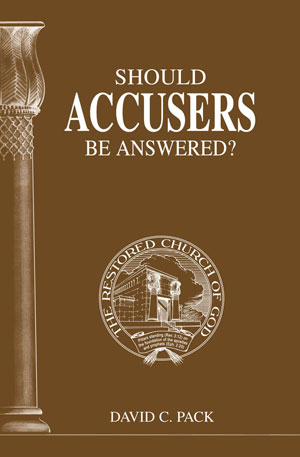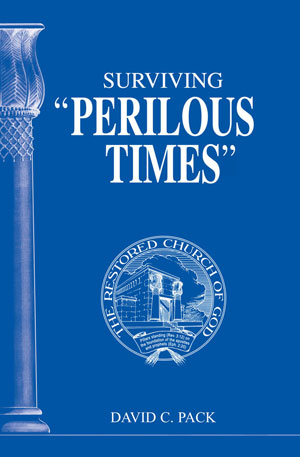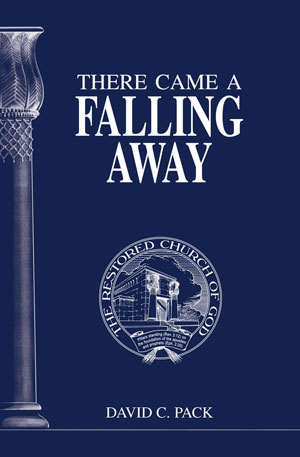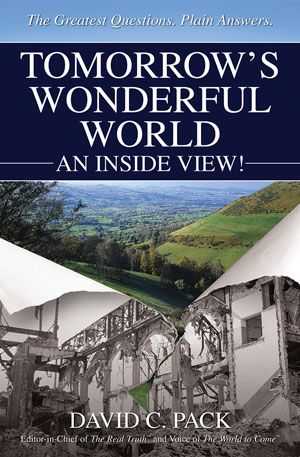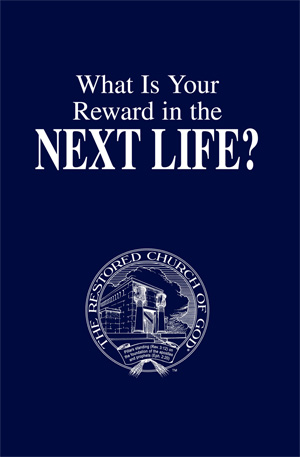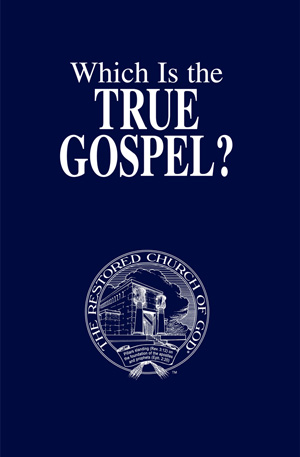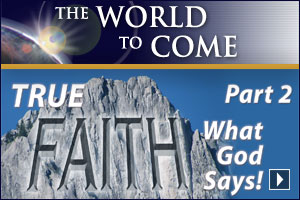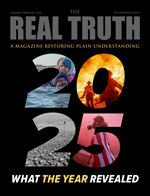Many have assumed the commission to prophesy again immediately precedes the work of the Two Witnesses, described just shortly after the first portion of Revelation 11. This is, in fact, almost true—but not quite. These same people have thought that the Church’s flight to safety also happens immediately at this point. This is almost true—but again, not quite. An incredible ongoing process culminating in a single final event parallels the whole period of prophesying again. It involves another specific and entirely different responsibility.
There is a profoundly important prophecy that culminates just after the short work ends, and just before the commission of the final two prophets in this age begins. This prophecy is so important that it requires that this be the book’s longest chapter. In fact, it is longer than any other two chapters in the book. You should find the puzzle that it unlocks so compelling that it is difficult to put it down.
Revelation 11 opens with a curious statement recorded by the apostle John instructing him to “Rise, and measure the temple of God.” Certain descriptive clues of this mysterious “measuring” are also given. The Tribulation is not introduced until the middle of verse 2 and the Two Witnesses are not directly mentioned until verse 3.
Most have never noticed or focused on this strange command. A few have, and still fewer have considered its meaning and implications. Similar to “prophesy again,” none have comprehended—and most have not understood at all—the seriousness of what it means!
You must understand!
You have seen that Mr. Armstrong laid the foundation to properly understand Revelation 10:11. Yet we saw circumstances in the Church and in the last days had to change—had to advance beyond his lifetime—before that prophecy could possibly be understood. The same is true of “Rise, and measure the temple.” However, Mr. Armstrong never to my knowledge even attempted to explain what this prophecy meant. You will learn why he would not need to know its meaning—but you do!
This chapter will closely examine this additional very dramatic prophecy. May God help you grasp—truly comprehend!—all that you are about to learn!
The Prophecy
Before continuing, it is helpful to read as one the overall context and flow of the three prophecies—(1) prophesy again, (2) measure the Temple of God and (3) the Two Witnesses—as they appear. Remember again as you read that the book of Revelation was recorded as a scroll. It originally lacked the chapters and verses that men came to think it should contain. While helpful in almost every instance through the Bible, these manmade “breaks” in the text can cause the mind to “break” with them in thinking. In this case, the closely connected time sequence that the text reflects gets lost if these three things are not read together.
Let’s then read Revelation 10:11 through 11:3 as a single block of Scripture, as it would have appeared to all Bible students for many centuries after it was recorded, when no chapter and verse were present. The bolded section is the part that most overlook:
“And I took the little book out of the angel’s hand, and ate it up; and it was in my mouth sweet as honey: and as soon as I had eaten it, my belly was bitter. And he said unto me, You must prophesy again before many peoples, and nations, and tongues, and kings. And there was given me a reed like unto a rod: and the angel stood, saying, Rise, and measure the temple of God, and the altar, and them that worship therein. But the court which is without the temple leave out, and measure it not; for it is given unto the Gentiles: and the holy city shall they tread under foot forty and two months. And I will give power unto my two witnesses, and they shall prophesy a thousand two hundred and threescore days, clothed in sackcloth.”
It is crucial to get the flow and its setting clearly in mind. This will better enable you to distinguish all the points to be understood within the text.
What is the “Temple of God”?
If you have been reading my books to the splinters and listening to key sermons referenced in the suggested order, it should now be clear to you that the Church Jesus Christ promised to build is the same as the biblical “Body of Christ.” This book has also referenced this several times. You have been brought to remember that this Church and Body is undivided, that it functions under the government of God, and that it exists to do the Work of God. If you have not proven—more correctly, reproven, for those with a Church of God background—what is Christ’s Body, all that follows will make little sense. (Again, you must read The True Church – One Organization, or Many?)
There is something else in this equation—another most crucial term—that must also be understood or vital knowledge is screened away, left impossible to understand. Only by understanding this additional vital element of knowledge can the meaning of “Rise, and measure the temple of God” be unlocked.
If one does not understand what is the “temple of God” as the term is found in the New Testament, there is no possible way to know what is to be measured in the above prophecy. For instance, if you were told to go measure “the skyscraper,” but not told where it is—which skyscraper, and in which city—and also what a skyscraper is—the assignment is impossible to fulfill. You would have no hope of carrying out the instruction.
Let’s understand the New Testament Temple of God.
Three Temples
The path to understanding Revelation 11:1-2 begins in the Old Testament with the temple that King David purposed to build. This first building replacing the tabernacle in the wilderness (that was in use for almost five centuries) is often called “Solomon’s Temple.” Begun in about 964 or 963 B.C., this perhaps most magnificent and beautiful of all structures ever built by the hands of men took seven years to complete. Overlaid and furnished in gold throughout, it remained in use for over 370 years, or until about 585 B.C., when it was destroyed by the invading army under Nebuchadnezzar, the king of Babylon. Of course, the Jews were taken into captivity in this same military siege against Judah and Jerusalem.
There is not space here to describe the awesome size and incredible splendor of this first “house of the Lord,” as Solomon’s Temple was also called (I Kgs. 6:37-38). Suffice to say, this stunning structure became the model guiding Mr. Armstrong in his desire to build the Ambassador Auditorium in Pasadena, which from the beginning was always affectionately—and respectfully—also referred to by the Church as the “House for God.”
In 539 B.C., the Medo-Persian empire defeated the Babylonians. God almost immediately after the victory commissioned King Cyrus of Persia to rebuild both Jerusalem and God’s temple (Isa. 44:28). Ezra 6:3-4 records Cyrus’ decree to carry out the instruction.
Begun in 537 B.C., this second temple, usually referred to as “Zerubbabel’s Temple,” took 21 years to complete—until 516 B.C. It remained in use for almost 500 years (497) until 19 B.C.
Zerubbabel’s Temple was also an extraordinary structure, but it was generally considered to be much inferior to Solomon’s in both workmanship and quality of materials used. In fact, these shortcomings became the pretext under which it was dismantled by Herod the Great, giving way to what is usually referred to as “Herod’s Temple” or the “Renovation of the Temple.”
Herod the Great (there are four Herods mentioned in the New Testament, this was the first), the builder of this “renovated” temple, reigned from 37 to 4 B.C. Having severely offended the Jews under his governorship, Herod desired to reclaim their affection through what he thought would be the ultimate gift—yet another temple that he wanted to build for them (but also as a monument to himself). He determined that it should exceed what he deemed to be the both inferior and incorrectly designed second temple built by Zerubbabel. After some convincing, the local Jewish leaders and citizenry signed on. Construction began in 19 B.C. and continued for 46 years (John 2:19-20) until late 27 A.D., the year beginning Christ’s ministry.
Built on top of a gargantuan foundation called “The Temple Mount,” roughly the size of 30 football fields, no one has ever determined how the huge stones in such a massive foundation were laid. Some single stones were as heavy as 600 tons, or 1.2 million pounds. When the Roman General Titus destroyed the temple in 70 A.D. (Matt. 24:2), he used battering rams to knock down each part of the building, including every stone “one upon another” just as Christ had foretold. But his legions could not dislodge the foundation stones, and neither could multiple earthquakes over the centuries to follow.
Thousands of finely shaped stones were brought in from Lebanon for construction in the “renovated” temple. A total of 1,000 priests, specially trained for the project, completed it well ahead of the projected schedule for final construction—thus allowing it to be in place before the arrival of Christ’s ministry. For comparison, this enormous renovation was actually 2½ times the size of the Temple of Giza in Egypt.
Daniel 9:25 describes a decree in 457 B.C., the seventh year of Artaxerxes, king of Persia (Ezra 7)—as part of the “70 weeks prophecy”—which revealed that the temple would be finished by 27 A.D., again, the year Christ’s ministry would begin.
Many brethren reading this date back to the time of the important Ambassador College “Big Dig” in Jerusalem in which a “50/50 joint participation,” as Mr. Armstrong put it, with Hebrew University took place. They will remember a project that began in late 1968 and continued into the mid-70s, during which the south wall of the Temple Mount was excavated. Specially chosen Ambassador College students were sent to work there each summer, and some others remained through the year, as this project was reported through regular updates to the Church and college by Mr. Armstrong and others. Of course, the Church understood this was in the very place from which the returning Jesus Christ will soon rule the entire world with the saints!
It is worth noting that the Bible actually describes in significant detail a future fourth physical temple in Ezekiel, chapters 40-48. To be built on Mount Zion in Jerusalem at the outset of the Millennium, this colossal building complex will even far exceed the size and splendor of Solomon’s Temple. It will have a veritable skyline of towers connected to it that will be the equivalent of 20-story buildings and will include immaculate dining facilities for the priests that just in themselves will be spectacular. (An artist’s depiction of this temple from The Good News magazine of May 1988 has been added, with an accompanying legend—next two pages—to aid in picturing various critical parts of the temple mentioned in the “measuring” prophecy. While interesting of itself, the elements of this rendering will take on more value later in the chapter.)
What Mr. Armstrong Taught About Yet Another Temple
But there is still another temple—a fifth temple, and also called the “House of the Lord”—which is described in the New Testament. This one is more important than all of the previous temples discussed put together. Before examining what the Bible says about it more closely, let’s look at what Mr. Armstrong understood and taught regarding the Church of God and its relationship to the New Testament Temple of God. Here is what he wrote to the Church in 1979. It lays the foundation for the rest of this chapter. (All emphasis, including underlining, is Mr. Armstrong’s.):
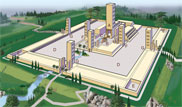
Ezekiel’s Temple
A – Main Temple
B – Inner Court
C – Altar
D – Outer Court
E – Cooking areas
F – Inner Gates
G – Outer Gates
H – Healing waters that flow from under the temple
“I know I have been chosen to carry the true Gospel around the world as a witness before Christ returns. BUT HE ALSO HAS COMMISSIONED ME WITH SOMETHING MORE—and VITALLY—IMPORTANT.
“Let me explain. When I was in England a few years ago, some of us were wondering how the temple was to be built in Jerusalem to which Christ shall come at His imminent SECOND COMING in supreme POWER and GLORY. Would the Israelis dare to demolish the Islamic ‘Dome of the Rock’ that now stands on the site of the temple to which Christ came over 1900 years ago? Would they build a new temple on that spot?
“But since then God has revealed additional prophecies. Let’s begin in the Book of Haggai. In Ezra 1:1-2, you’ll read of how God influenced King Cyrus to issue a proclamation sending a colony of Jews back to Jerusalem to build the second temple—70 years after the destruction of Solomon’s temple.
“The Governor and head of this colony was Zerubbabel, who was sent as the builder of this second temple to which Christ came at His first coming, more than 1900 years ago.
“You read of this in Haggai 2. In reference to the temple, God said through Haggai, ‘For thus saith the Lord of hosts; Yet once, it is a little while, and I will shake the heavens, and the earth, and the sea, and the dry land; and I will shake all nations, and the desire of all nations shall come [till the treasures of all nations are brought hither (Moffatt translation)]: and I will fill this house with glory, saith the Lord of hosts. The silver is mine, and the gold is mine, saith the Lord of hosts. The glory of this latter house shall be greater than of the former, saith the Lord of hosts: and in this place will I give peace, saith the Lord of hosts’ (Haggai 2:6-9).
“Notice! This is a PROPHECY—for the future. The TIME? The present and immediate future.
“The theme at the beginning of chapter 1 has been the building of the second temple. Then, in the verses above quoted, it becomes a PROPHECY—no longer a history of Zerubbabel building the temple over 500 years before Jesus came, yet the same temple to which He came at His first coming. But suddenly the HISTORY changes to PROPHECY of our time now, and it speaks of the temple—this ‘latter-house’—having glory far greater than that of Solomon’s temple. Now what temple is it talking about? The one Zerubbabel built was no where near as glorious as Solomon’s temple!
“But THIS IS NOW PROPHECY—no longer HISTORY! It is speaking of OUR TIME, late in the 20th century! This ‘latter house’ is the temple to which the GLORIFIED CHRIST shall come at His second coming—soon now, in our lifetime. It is speaking about the temple to which the GLORIFIED Christ shall come in our day!
“But this time Christ is not coming as a human, to die and give His life for us! This time He is coming IN SUPREME POWER AND GLORY to RULE ALL NATIONS! He is coming as the all-SPIRITUAL GOD! And He is not coming to a physical people who, 1900 years ago, rejected Him—or to a temple of stone, gold, silver, and wood. You find the temple to which He will come this time described in the NEW Testament:
“‘Now therefore ye are…fellow-citizens with the saints, and of the household [family] of God; and are built upon the foundation of the apostles and prophets, Jesus Christ himself being the chief corner stone; in whom all the building fitly framed together groweth unto AN HOLY TEMPLE IN THE LORD’ (Eph. 2:19-21).
“Brethren in Christ, WE ARE THAT TEMPLE!”
Co-Worker Letter, July 24, 1979
This is a very plain statement—and final scripture—and it is absolutely filled with meaning. It introduces one of the most astonishing truths in the entire Bible. You will discover that it becomes the path to understanding Revelation 11:1-2. In fact, without it we have no basis for knowing what John was told to measure, and also, you will see, for learning how the measuring would be accomplished.
Now it should be obvious why the instruction to John involved a temple of greater glory than any of the first three described. The period referred to in context by Haggai is obviously the Day of the Lord—when all nations will be shaken!—and the time of the returning Jesus Christ, Who will be coming to the Church, now “grow[ing] unto an holy temple in the Lord.”
So, the New Testament Church of God—the same as the biblical Body of Christ—is here described as the “temple of the Lord,” and it still means the place where God dwells. But are there other New Testament passages that amplify what Mr. Armstrong recognized?
There are several, and they are crucial to understand.
The New Testament Temple
The term “temple” is used in a host of contexts throughout the New Testament. This word appears literally scores of times through the gospels and epistles of Paul, as well as in various places in the book of Revelation, usually there referring to the Temple of God around God’s throne in the third heaven.
The English word “temple” generally derives from three separate Greek words that can correctly be translated as “temple.” These are oikos (oy’ kos): “a dwelling, by implication a family home, household or temple”—hieron (hee-er-on’): “a sacred place, that is, the entire precincts of the temple (at Jerusalem or elsewhere)”—and naos (nah-os’): “a feign shrined temple—the central sanctuary itself.”
Let’s examine a few additional verses that remove all doubt about what—who—is the Temple of God today.
John 2:19-21 is the place to start. It offers important proof that the Body of Christ is the same as the Temple of God. As you read, realize that Christ’s words are the Bible interpreting the Bible, and they provide the best introduction to the subject of the New Testament Temple. Note especially the final part: “Jesus answered and said unto them, Destroy this temple, and in three days I will raise it up. Then said the Jews, Forty and six years was this temple in building [Herod’s renovation], and will you rear it up in three days? But He spoke of the temple of His body.”
If you understand that Christ’s “body” is also His “temple”—and that the “temple” is “His body”—obviously the same as the term “Body of Christ”—you cannot get confused. All you must do is take Christ’s words at face value. The Bible has here interpreted itself.
What Paul Recorded
Paul recorded the most about the New Testament Temple. He wrote this to the Corinthians: “For we are laborers together with God: ye are God’s husbandry, ye are God’s building” (I Cor. 3:9). Note this. Unlike today’s English, the King James translators carefully used “ye” whenever the intent was plural and “you” when it was singular. The ye here means all of the Corinthians, or thus the whole Church, collectively. It will become clearer as we proceed that individual members are not the Temple of God, but rather the entire Church as a whole comprises the Temple.
We will later come to understand how the Bible describes—the term that it uses for—individuals within that Temple.
A few verses later Paul added this: “Know ye not that ye are the Temple of God, and that the Spirit of God dwells in ye? If any man defile the Temple of God, him shall God destroy; for the Temple of God is holy, which Temple ye are” (vs. 16-17). Each time “temple” appears, it is naos in the Greek, meaning the central or inner sanctuary.
Placed together, these verses reveal that God sees His people as both His Building and His Temple. God is building a Temple—a House. I Corinthians 6:19 adds a little more. It also makes clear how serious it is if we treat lightly the incredible privilege it is to have God dwelling in us—if God’s people do not conduct themselves in a manner that reflects this.
But the second epistle to the Corinthians adds significantly more. Let’s notice: “And what agreement has the Temple of God with idols? for ye [notice the plural pronoun is used throughout here] are the Temple of the living God; as God has said, I will dwell in them, and walk in them; and I will be their God, and they shall be My people” (6:16).
The last part of this passage is a quote from Leviticus 26:12. Its use here demonstrates God has always planned that His Church, those in whom He would in the future personally dwell, would be the greatest—truly the most glorious—temple of all. Remember, Leviticus was recorded long before either Solomon’s or Zerubbabel’s temple was built.
Also, there is a powerful message for everyone in the splinters in the preceding verses leading up to the verse 16 quoted above. For those who desire to be in God’s Temple, there exists no room—none!—for doctrinal compromise with any of the false teachings of counterfeit Christianity—summarized as “unrighteousness” and “darkness”—now invading and infecting all the splinters. We are to “touch not the unclean thing” (vs. 17)—any unclean thing.
Pause to read verses 14 and 15. Then take the time to read each phrase in Ephesians 5:6-11, followed by verses 23 and 30. The first group of verses condemn all compromise with every form of unrighteousness. (This issue will rear its head later when we examine the three things John was told to measure.) The latter two verses tie Christ as Head of “the Church” to those in it being what He considers the individual “members of His Body, of His flesh, and of His bones.”
Let this understanding of exactly what it means to be in the Body of Christ sober you!
Church, Body and Temple—Three Critical Verses
One final proof (there are several others) that the Church of God, the biblical Body of Christ, the House of God and the Temple of God are the exact same thing is understood by carefully comparing three additional passages in Paul’s epistles. Follow very closely the incredible connection between these important passages.
Do not miss what they reveal!
Let’s begin by looking at I Timothy 3:15. This crucial but largely ignored bedrock passage provides the New Testament definition of the true Church of God. While most have forgotten it, this verse has always been there. The Church is there called “the house of God, which is the Church of the living God, the pillar and ground of the truth.” (Take more than a passing interest in the fact that this verse directly ties the Church to where “the truth” is—not “some of the truth” or “much of the truth” or even “most of the truth”—and certainly not “truth mixed with error”—but rather simply “THE TRUTH”!)
Then, get clear in your mind that the Church is called “the house of God.” (It is also more than interesting that this is virtually the same term used from the beginning regarding Solomon’s Temple—which was generally referred to as the “House of the Lord,” or “God’s House,” as in I Kings 6:37-38.)
Next, recall that Mr. Armstrong in his statement referenced Ephesians 2:19-21. Also recall that Paul called the Temple of the Lord a “building fitly framed together” in that passage. Later, in chapter 4 of Ephesians, he said the identical thing about the Body of Christ. Notice: “From whom the whole body fitly joined together and compacted [I Corinthians 12:24 adds “tempered together”] by that which every joint supplies, according to the effectual working in the measure of every part…” (vs. 16).
The phrases translated “fitly framed together” and “fitly joined together” derive from the very same Greek word sunarmologeo. It means “to render close-jointed together, i.e. organized compactly, be fitly framed (joined) together (in the sense of laying).” Paul obviously had the same thing in mind whether he was discussing the Church, the Temple (or House of God) or the Body of Christ.
Sunarmologeo offers truly fascinating meaning. The beginning and last portions of the definition—“render close-jointed” and “together (in the sense of laying)”—carry the obvious meaning of laying individual bricks or stones that are mortared or put “close-jointed” beside each other (“together”) as one would lay them in rows within a building.
Since we saw that the Temple is also called God’s “building,” there is no possible way to read these passages and conclude that the true Church of God could be anything other than one undivided organization—a single building! Do not let anyone ever again tell you that God’s Temple is anything less than this! His Building cannot be “spiritualized away”—as do Protestants with every doctrine in God’s Word—into a “temple” that is ill-defined, disconnected, amorphous—and meaningless.
Now let’s look more closely at the “bricks” or “stones” used in building—exactly what or who it is that lies together “close-jointed.” At this point the knowledge presented in this chapter becomes personal.
An Astonishing Passage in I Peter!
The apostle Peter put an exclamation point—a capstone if you will—on all that Paul wrote about the New Testament Temple.
This first of his general epistles declares this to what would include all true Christians through the ages: “If so be ye [plural again] have tasted that the Lord is gracious. To Whom coming, as unto a living stone [referring to Christ], disallowed indeed of men, but chosen of God, and precious, ye also, as lively [living] stones, are built up a spiritual house, an holy priesthood, to offer up spiritual sacrifices [on God’s altar], acceptable to God by Jesus Christ. Wherefore also it is contained in the scripture, Behold, I lay in Zion a chief corner stone, elect, precious: and he that believes on Him shall not be confounded” (2:3-6).
It is obvious the living stones (Christ being the Chief Corner Stone) are the individual Christians in the Temple lying “close-jointed” or “fitly framed” together. And note that it was only the priests who could enter and serve in Solomon’s Temple (II Chron. 23:6). Also, it is important to recognize that verse 5 should carry the stronger rendering of the positive command “be ye [BE YE!] also living stones,” as is found in the margin of many Bibles.
This is absolutely incredible understanding, for those able to receive it—for what should be a second time! Get it firmly in mind before continuing. Everyone with God’s Spirit alive today should give much more than mere pause in determining whether they are fulfilling this meaning and purpose—what is a command!
Peter wrote more, and our understanding cannot be complete without it: “Unto you therefore which believe He is precious: but unto them which be disobedient, the Stone which the builders disallowed [or “rejected”], the same is made the head of the corner, and a stone of stumbling, and a rock of offense, even to them which stumble at the word, being disobedient: whereunto also they were appointed. But ye are a chosen generation, a royal priesthood, a holy nation, a peculiar people; that ye should show forth the praises of Him who has called you out of darkness into His marvelous light” (vs. 7-9).
The world has never been willing to accept the true Jesus Christ! Neither will they accept the Church He built—and is still building. They “stumble” at His doctrines, and reject—“disallow”—Him as the Head of the Church—any Church. In His place they have brought a cold, dead Jesus (called “another Jesus”), who brings dead understanding (empty false doctrines), and who builds dead churches out of dead stones!
The Tragedy Today
But here is an infinitely greater tragedy, one that is the story of our time and of the final Church era: Most in the splinters have come to feel much the same as their worldly counterparts, but with no recognition that this has happened.
They will no longer hold precious the true Christ of the Bible. Neither will they hold to His truth. They will not yield to His government. Neither will they come to His Church, nor support His undivided Work. And they will no longer permit Him to head their lives—and to continue building them into His House. Blind to their actions, they have placed themselves outside the Temple He is constructing. They have unwittingly chosen not to be placed next to the “living stones” with which He is building. These are the foolish virgins of Matthew 25.
Get this. You are being judged on these things—NOW! The same apostle Peter also said two chapters later that “Judgment is now on the house of God” (4:17).
Brethren of the splinters, the Church has long understood that the “House of God” is His Church. By now you know this is the same as saying “His Temple”—of which you were called to be a “living stone,” one “closely joined” with all the others in God’s unified “Building.” (But this will soon be seen to be a house of more than one dimension—more than one parameter.)
Why cannot people today any longer seem to remember that God’s Church—the Body of Christ—His House or Temple—is obviously one, undivided organization ruled by Jesus Christ as Head under the government of God—and doing His Work? (Four detailed sermons about the Temple of God are available on our website. They carefully discuss all you have learned—and will yet learn—in this chapter. Parts 1 and 2 are titled “The Greatest Building!”, with Parts 3 and 4 titled “Measure the Temple.” Do not miss them!)
What could be more important for you to understand than these points? What could be more important to you than allowing yourself to be placed by Christ back into the Temple—into the “House of God”—recognizing that even it is still being judged?
What could be more important to you than recapturing the basic, but all-important, knowledge that God’s people sang at Sabbath services for decades? How could so many forget that “Except the Lord build the house, they labor in vain that build it” (Psa. 127:1)? There is but one House God could have had in mind here, the one He planned long before the Psalms were recorded. How could splinter leaders think they can build their own “houses” and that Christ would follow their lead instead of the other way around?
And how could so many blindly help them build?
The majority today have made themselves “branches cut off” from Christ—not yet dead in most cases, but rather having made themselves dying stones, stones with the “oil” of God’s Spirit flowing out of their “lamps” without replenishment from Christ. (Many have already died.) They are “branches” cut away from the “Vine”—stones removed from the Builder! We will momentarily revisit this in the context it deserves.
So tragically, most simply no longer seem able to realize—or even remember—that Philadelphians are promised to one day be “pillar[s] in the [coming] Temple of…God” (Rev. 3:12).
How did all this incredible knowledge get lost to thousands?
Back to Zerubbabel
God’s people are without excuse. They were once aware of an extraordinary biblical parallel that guided their understanding of what God was doing within His Temple—of what the Worldwide Church of God was under Mr. Armstrong’s leadership.
The following quotes from another quite extensive Co-Worker Letter of March 19, 1981 explains what I reference—what people once knew but have now forgotten. In it Mr. Armstrong took further what he said about Zerubbabel’s Temple, and the latter-day “glorious Temple.” He was telling the Worldwide Church of God (and co-workers) about extraordinary knowledge revealed in Malachi, Haggai and Zechariah, having to do with Zerubbabel, the local governor who we saw presided over the rebuilding of the second temple. I have left in some repetition from the earlier quote to bring helpful context.
Read carefully and allow Mr. Armstrong’s words to teach you again. I have broken his instruction into three excerpts (All emphasis is his):
“Now consider the prophecy of Malachi 3:1-5. In verse 1, God will send a human messenger to prepare the way before Christ, coming as the Messenger of the New COVENANT. Now what coming of Christ is this prophecy talking about? Read verses 2 to 5. Jesus did none of those things at His first coming—but WILL DO THEM AT HIS SOON SECOND COMING! So the prophecy is, actually, foretelling primarily a messenger to prepare the way for His SOON SECOND COMING!
“Yet Mark 1 and other New Testament scriptures identify John the Baptist as fulfilling that prophecy.
“But REMEMBER GOD’S PURPOSE WORKS IN A PROCESS of DUALITY! John the Baptist was a TYPE or forerunner, of one to prepare the way for His Second Coming. Jesus is to come to His TEMPLE (Mal. 3:1). He came to a material temple of stone, wood, gold and materials A.D. 27-31. To what Temple will He come IN OUR TIME, SOON NOW?
“Hold this prophecy of Malachi 3 in mind, and turn to Haggai 2, beginning verse 3. Zerubbabel was governor of a colony of Jews sent from Babylon back to Jerusalem 70 years after destruction of Solomon’s temple, to build a new temple. This also was the days of prophets Ezra and Nehemiah. Zerubbabel was builder of this second temple. It was the temple to which Jesus came at His first appearing as a human.
“Verse 3, the former temple of Solomon was then as nothing compared to its original physical glory. God commands Zerubbabel to be strong and work to build the temple (verse 4). Verse 6 goes into a far-future prophecy of a time just before Christ’s Second Coming, when God will shake the earth and shake all nations, and the ‘GLORY OF THIS LATTER HOUSE SHALL BE GREATER THAN OF THE FORMER’ (verse 9). The temple Zerubbabel built of stone, wood and physical materials was nowhere near as glorious as the former temple of Solomon! This is a PROPHECY speaking about the temple to which Christ shall come the second time, in supreme POWER and GLORY—a temple far more glorious than Solomon’s!
“To WHAT temple will Christ come very soon now? Are the Jews going to demolish the Moslem temple, Dome of the Rock, which stands on that site now, and build a new super-glorious new temple? NO! Turn to Ephesians 2:19-22. The Church at Ephesus was composed of former gentiles. They are no longer foreign gentiles, but fellow-citizens with the saints—a spiritual NATION. They are also a FAMILY—of the ‘household’ of GOD—the GOD FAMILY. As a BUILDING they are built upon the foundation of the apostles and prophets, Jesus Christ being chief cornerstone. As a BUILDING, they are fitly framed together (in UNIFIED ORGANIZATION) growing into a HOLY TEMPLE!” (Author’s note: Give special attention to “in UNIFIED ORGANIZATION.”)
This first segment sets the table for the new understanding to follow. Be sure to stay with the different parts of what Mr. Armstrong connects:
“Zerubbabel built the second temple to which Jesus came the first time. John the Baptist prepared the way before the FIRST coming. But WHO was to build the SPIRITUAL temple to which Christ shall soon come the second time? Who was to prepare the way before His Second Coming?
“Remember God does things in DUAL stages. As Zerubbabel built the first temple of MATERIAL stone, wood and other materials, he was a forerunner or type of one through whom Christ would raise up or build the SPIRITUAL TEMPLE—His Church of our time, prior to the Day of the Lord and Christ’s Second Coming. As John the Baptist prepared the way, in the PHYSICAL wilderness of the Jordan River for the first coming of the HUMAN Jesus (both man and God), then coming to His MATERIAL temple, and to His PHYSICAL people Judah, ANNOUNCING the Kingdom of God to be set up more than 1,900 years later, SO God would use a human messenger in the SPIRITUAL wilderness of 20th-century religious confusion, to be a voice CRYING OUT the Gospel of the KINGDOM OF GOD, about the SPIRITUAL CHRIST, coming in SUPREME POWER AND GLORY to His SPIRITUAL TEMPLE, to actually ESTABLISH that spiritual KINGDOM OF GOD.
“Brethren, HAS THAT BEEN DONE BY THIS CHURCH?
“Did God raise up a one-man LEADERSHIP to be used by Him in building this spiritual TEMPLE and in proclaiming after 1,900 years the true GOSPEL OF THE KINGDOM OF GOD in ALL THE WORLD—to even go to kings and heads of nations (Rev. 10:11)—in bringing the Church back to the FAITH ONCE DELIVERED (Jude 3)?
“HAS THIS HAPPENED, IN YOUR DAYS, AND HAS GOD BROUGHT YOU INTO THIS PROPHETIC FULFILLMENT AS A PART OF IT?
“HAS ANYONE ELSE DONE IT?”
A Type
The whole Church once thrilled to such powerful announcements, particularly those of the last four smaller paragraphs. By now, if you have read the books to the splinters in the suggested order, you have seen that Mr. Armstrong fulfilled the role of the final Moses to precede Elijah, who would appear shortly before Christ’s Second Coming. But have you remembered—did you not once understand?—that he also fulfilled another parallel role concerning a special prophecy, typed by Zerubbabel?
Let’s learn what he taught:
“I have shown you that the book of Haggai is a PROPHECY. Zerubbabel’s temple, to which Jesus came at His first coming, was a TYPE of the SPIRITUAL TEMPLE (God’s CHURCH) to which, in its resurrected GLORIFIED state, it will be the GLORIOUS TEMPLE to which Christ will come SOON NOW IN OUR TIME.
“Zerubbabel, therefore, was the typical forerunner of one Christ would use to build that GLORIFIED SPIRITUAL TEMPLE—God’s Church of this END TIME.
“In Zechariah 4:6 and 9, God says of this former type: ‘This is the word of the Lord unto Zerubbabel, saying, Not by might, nor by power (humanly), but by MY SPIRIT, saith the Lord of hosts.’ In Revelation 3:8, Christ says of the leader of today’s Church, ‘I know thy works; behold I have set before thee an open door, and no man can shut it: for thou hast a little strength (only a little strength humanly), and has kept my word, and hast not denied my name.’ This Work in our day has not been done by human strength or power, but by FAITH and the POWER OF GOD’S SPIRIT.
“Further, ‘The hands of Zerubbabel have laid the foundation of this house (the first temple); his hands shall also FINISH IT!’ So far as I know, GOD HAS NOT RAISED UP ANYONE ELSE TO FINISH THIS WORK HE HAS USED ME IN DOING!
“God could take my life in the next breath—or He has power to keep me on the job as His instrument for as long as He deems necessary.
“I have NEVER SAID I expect to live until Christ comes.
“But, just in case of my disability for any reason, to prevent Satan from causing division, I feel God has inspired me to delegate power to the Advisory Council, during any such complete disability, to take full charge of the Work and all its assets and activities.”
Powerful Meaning!
This final excerpt practically explodes with meaning, and several points must be emphasized.
First, the ancient Judean governor Zerubbabel was a direct type of what Herbert W. Armstrong would be used to do with a much greater Temple to come later. Second, Mr. Armstrong would lay the foundation of the New Testament spiritual Temple at the end of the age. Third, it was foretold that Mr. Armstrong would “break off” (the correct translation of the Hebrew word batsa, rendered “finish” in Zech. 4:9) from what he started, meaning the Church of God would be built on the right foundation and it would later be completed as a marvelous finished spiritual product unlike anything the world had ever seen!
The fuller context of what Zechariah wrote makes this even clearer: “Then he [an angel] answered and spoke unto me, saying, This is the word of the Lord unto Zerubbabel, saying, Not by might, nor by power, but by My Spirit, says the Lord of hosts. Who are you, O great mountain? before Zerubbabel you shall become a plain [not even mountains would get in the way of what God purposed]: and he shall bring forth the headstone [the true Christ?] thereof with shoutings, crying, Grace, grace unto it. Moreover the word of the Lord came unto me, saying, The hands of Zerubbabel have laid the foundation of this house; his hands shall also finish it [the House]; and you shall know that the Lord of hosts has sent me unto you. For who has despised the day of small things? for they shall rejoice, and shall see the plummet [plumb line or plumb bob] in the hand of Zerubbabel…” (4:6-10).
A plumb line is a carpenter’s instrument that is used in conjunction with a level for the purpose of getting the perfect right angles, necessary for building walls, roofs and floors of buildings. All construction must be straight to be correct, and observant owners will not tolerate anything less. Any contractor who forgets this basic rule will soon be in another line of business.
Christ has been no different in building His Church. He would not use—nor would he tolerate—a “contractor” who could not “get things straight.” The all-powerful Christ is a perfect master builder, and One Who would—and did—carefully select the right human contractor, one He personally trained and prepared. Christ also recognizes He is the most important stone within His own building—that He Himself is “built in.”
Now understand. Mr. Armstrong did not just build and finish God’s Temple during the Philadelphian era, but, through God’s Spirit and power (vs. 6), he got things STRAIGHT! His work at the human level left in place a New Testament “building” that was correctly “trimmed” as any carpenter would do this. Under Christ’s guidance, Mr. Armstrong got STRAIGHT a host of true doctrines, Church government, the Great Commission, the Ezekiel Warning, the importance of the Second Commission, feeding the flock—and everything else necessary for the successful working of an enormous worldwide organization. An immense world headquarters complex, three colleges, numerous regional offices, summer camps, AICF, and other things were all part of this. As my book on God’s government described, the Church of God in the twentieth century was a beautiful, efficient, productive—SYMMETRICAL—structure, I repeat, simply unlike anything the world had ever seen!
But scores of thousands forgot what they witnessed!
A final ancillary point of clarification belongs here. The last portion of Mr. Armstrong’s third excerpt could seem at first glance to indicate he thought he would finish the full Work of God for this age. A closer reading makes clear that, since Mr. Armstrong was well aware he could die before the Tribulation, he had to be referring to finishing his own assignment—the work given to him personally, as described in Malachi, Haggai and especially Zechariah. Of course, his prophesied responsibility—his “assignment” prophetically, if you will—also included the first fulfillment (of “prophesy again”) of Revelation 10:11. This had to be completed—be a finished responsibility or “work”—before the latter fulfillment of that prophecy could come to pass, as it is now.
Related to this, the prophecy in Zechariah could not have meant that no more “living stones” (I Pet. 2:4) could be added to the Temple after his lifetime. Several parables, particularly Matthew 22:4-14, Luke 14:12-24, but also Matthew 20:1-16, demonstrate that certain others would be called right up until the last minute at least in part to fill the empty seats at the Wedding Supper that, in some cases, others selected earlier had vacated. Mr. Armstrong could not possibly have equated his responsibility with who could be called to finish the final number that God desired at the Wedding Supper.
Do not let anyone with his own agenda about whether the Great Commission was completed in 1986 confuse you regarding what Mr. Armstrong simply could not have meant in this statement, if he were to remain consistent with everything else he said on this subject!
A Type—and an Analogy
Just the knowledge that has been presented to you in this chapter so far is of paramount—absolutely supreme—importance to your future! Now consider the following parallels.
Solomon’s Temple has always been understood to be a type of Christ building His Temple—the New Testament Church. Zerubbabel’s Temple you have now seen is a type of Mr. Armstrong finishing and plumbing the New Testament Temple foundation during the Philadelphian era.
There is another kind of parallel or helpful analogy that will aid you in understanding the remainder of the chapter.
Recall the renovation of the dismantled second temple that was in place when Christ came for the first time as Savior, and to build His Church. The Restored Church of God is truly the renovated Church—the renovated Temple!—of the Philadelphian era. While others have claimed to be the true Church, or part of it as the now “greater Church of God,” Restored really is exactly the same as the Church that Christ led Mr. Armstrong to re-establish—to “build,” “finish” and “plumb.”
Of course, it is for you the reader to prove if this is true!
Back to Chapter Title
At this point, this chapter of the book becomes most fascinating, but only for those who have understood what has been covered to this point. All that comes next will be among the most sobering things you will ever read, with conclusions coming both during what follows and at the end. Therefore, open your mind. Give yourself a chance to comprehend almost unbelievably potent realities—and stunning, even stupefying, prophecies—soon to crash into place, some upon the world and others upon God’s lukewarm people.
This chapter is titled “Measure the Temple.” However, it easily, and technically more correctly, could be titled “Measure the Temple, the altar, and them that worship therein.” John’s instruction to “Rise, and measure” involved much more than what is the starting point of God’s Temple, and there are enormous reasons for this that will become evident. Other elements of the Revelation 11:1-2 description have to also be understood for the whole passage to come together—to bring out the powerful meaning God intended.
You are now prepared to understand the instruction given to John. Before continuing, open your Bible to the passage and keep it there because we will be referring to several key words within it. You will need to continually check the context to appreciate all that you are about to learn.
Everyone is familiar with puzzles. You have probably made several, starting from childhood when only six or eight pieces formed the complete picture. In a sense, Revelation 11:1-2 forms a basic puzzle with “pieces” of similar number. Recognize that each word or phrase to be explained is one piece of a puzzle whose picture only becomes clear when the last piece is in place. Miss a few or even a single piece and you will miss most or all of this puzzle!
No “Interpretation” Necessary
As you read, you will see that no human interpretation of “measure the Temple” is necessary. The Bible and the simple meanings of key words in the Greek will be seen to do all of the work for us. All you must do is accept Scripture and basic word definitions, and remember Mr. Armstrong’s statement a few pages back regarding Revelation in general and chapter 10 in particular. He said that “There was NO WAY it [the prophecy] could have been understood then—until after subsequent events…” had occurred.
Do not permit the assignment to be more complicated than this! “Subsequent events” have occurred, and they have permitted God’s plain meaning to open to us as a result.
John—A Type of Another Later
Like the instruction appearing as though it is to John to prophesy again, the assignment to “measure the Temple” also cannot actually refer to John. This would be no more possible for a man living 2,000 years ago than would be Ezekiel’s assignment to carry out today the “watchman” responsibility (of 3:17 and 33:1-9) when he lived 26 centuries ago. It is clear from the previous chapter that these assignments were designated to men living in the last days.
It should be obvious that the instruction also could not possibly apply to Mr. Armstrong. If you understood just the last chapter, as well as the fact that the Revelation 11:1-2 setting immediately leads up to and precedes the arrival of the Great Tribulation, this much is clear. This is a reality some cannot accept, but the setting “is what it is.”
Notice again that the prophecy is sandwiched into the text immediately before the mention of the Two Witnesses, meaning the Two Witnesses could not be candidates to fulfill the instruction. (After all, there are two of them.) Understand that they have not yet been introduced in the text, and their “job description” lacks any such mention in an assignment that is said to only last the 1,260 days of the Great Tribulation.
The instruction is to one person—the same man whom John types within the instruction to “prophesy again.” Notice that Revelation 10:11 begins, “And he [the angel] said unto me [John]…”, similar to how 11:1 begins, “And there was given me [John again, meaning the one he types]…” to fulfill this extraordinary duty.
Any attempt to say that either John, Mr. Armstrong (that he either did this in the past, or that he will be resurrected to do it, as some believe) or the Two Witnesses—or any other individual—fulfill this passage is to force the meaning. So is the obvious assertion that the Temple of God is already being measured now by the idolatrous, blaspheming splinter “prophet” who claims to carry “Aaron’s budded rod” given him for this task. However ridiculous this is to the thinking Christian, thousands have fallen for this idea.
Remember that Satan counterfeits everything, so do not fall for any of these theories!
Now realize that there is no other Temple that the passage could be referencing than God’s spiritual Temple today—Christ’s New Testament Church or Body. Obviously, no human being is capable of measuring the Temple of God in the third heaven at God’s Throne (Rev. 14:15, 17, etc.), nor would there be a reason for one to measure any possible future physical temple in Jerusalem. If so, how would any man accomplish such a task, particularly when there is no clear indication that such a temple will be built? And again, why would God assign such a thing? Also obvious is that it cannot be talking about measuring the not-yet-here temple described in Ezekiel 40-48. And finally, the temple of God described in Revelation 21 and 22 cannot be a possibility for measurement because its arrival is even farther into the future—and it would involve a man “measuring” God and Christ.
Finally, there is the matter of the time setting of the prophecy. Considering its location in the text—sandwiched between two giant prophecies—on what basis could God expect us to conclude this is other than something culminating immediately after God’s Work (prophesying again) is finished and immediately before the arrival of the Two Witnesses?
Unless one ignores the prophecy’s location, there is no other “time” possibility.
Be sure to get all these preliminary issues completely straight in your thinking before continuing. Do not allow yourself to think “Mr. Pack is leading the reader.” Be sure you see the natural, scriptural “funnel” into which God leads those who desire to know the plain meaning we will learn. (Beginning now, the key phrases in the prophecy form subheads in all capital letters to differentiate them from other subheads within the flow of explanations given.)
“A REED LIKE UNTO A ROD”
We can now begin with the first phrase in the prophecy—that John was given by the angel “a reed like unto a rod.” First, simply notice that it was neither a reed nor a rod per se, but rather the phrase must be taken for what it says. But what does it mean?
The Greek word for “reed” is kalamos, meaning “A reed (the plant, or its stem), by implication: a pen.” From all indications, such a reed was a long stem-like object, perhaps most like a pole, to be used for measuring. It is interesting that the Hebrew word for reed is kaneh, which carries an almost identical meaning: “A reed by resemblance of a rod, especially for measuring; shaft, tube, stem, or a stalk.” (For instance, Ezekiel 40:5 speaks of “in the man’s hand a measuring reed of six cubits long, by the cubit and an handbreadth: so he measured the breadth of the building, one reed; and the height, one reed.” This leads into the nine chapters introducing the physical millennial temple to come of Ezekiel 40-48.)
Mark 15 records two places where the meaning of a reed is obviously not a mere flimsy stem or stalk of a plant. In verse 19 it says that “they smote Him [Christ] on the head with a reed [again, kalamos]…”, and in verse 36 is added, “one ran and filled a sponge full of vinegar, and put it on a reed, and gave Him to drink…”
So far there is no difficulty in understanding, but what about “like unto a rod”? The Greek word for rod carries fascinating meaning. It is “A stick, wand, cane; baton of royalty; scepter, staff.”
This adds much more to the meaning of the phrase. It becomes clear that the instrument given to John is one that both has substance and carries ruling authority, as would a scepter. But there would have to be a fixed standard in place so that proper measurement could occur when there was need. It is interesting that the English word canon derives from the Hebrew kaneh, which we just saw defined. It is also interesting that the apostle John was the last person whom God used to finalize the canonization of the New Testament, and thus the whole Bible.
It should not be difficult to see that the scriptures themselves function as “a reed like unto a rod,” and, when in the hands of God’s appointed leader, typed by John, they become the ultimate measure of the Temple, altar and worshippers. Take a moment to read Hebrews 4:12, II Timothy 3:16-17, Revelation 20:12, I Peter 4:17 and John 10:35 to see that God’s people are not only under judgment now, but the measure by which they are judged is Scripture!
It will help to think of how Mr. Armstrong led the Philadelphian era of the Church over a 52-year period. The only standard by which he “measured” everything was the plain word of God.
“RISE”
The definition of the Greek word for “Rise” is egeiro, and it means “To awaken, rouse from sleep, from setting, or from inactivity.” Notice it can have two alternate meanings, with the first one the obvious applicable meaning here—“from setting.”
Since the one described in this prophecy would obviously not be asleep and in need of being awakened, the latter meaning applies—to rouse from one’s “setting” to another. (Again, just as obvious would be that this leader would hardly have been “inactive” prior to this change in setting.) It will be seen as the picture here develops that this man will, in fact, change very suddenly from previous setting to the work of Revelation 10:11 and to that of the stunning responsibility you are about to understand.
Keep this simple. To look for more than this is to overanalyze the word. Remember, no human interpretation is necessary.
“MEASURE”
The next key word to be defined comes from the Greek metreo, meaning “To measure; ascertain in size by a fixed standard.”
It is not hard to see from where the English word meter derives. The universal standard for distance and measuring almost the world over springs from this Greek word—kilometer (1,000 meters), centimeter (1/100th of a meter), millimeter (1/1,000th of a meter), etc.
It becomes absolutely clear that John’s instruction includes a highly-defined standard, one that cannot be misunderstood by those who know anything at all about measuring. Understand this. There is absolutely nothing on Earth—or in life—that can be measured without use of a fixed standard!
Other standards, whatever they might be speculated to be in this case, would not and could not apply. For instance, in the United States, unlike the rest of the world, distance and measurement is counted in inches, feet, yards and miles. Travelers and businessmen operating here must constantly adjust for this difference. For purposes of illustration, it could be said that America falls short of the world’s “meter” standard.
Do not be confused by this second reference to a fixed standard. You may be thinking that the Bible has already been established as God’s ultimate standard for measurement. That is certainly true. However, history shows that the Bible can mean “a million things” to “a million different people.” This is why Christendom is split thousands of ways, and the splinters are divided into hundreds.
The one given this assignment cannot be in confusion about exactly how he uses his biblical reed/rod of ruling authority in carrying out the measuring assigned him. He must know exactly how to fulfill his duty! And this must be a man first ruled by God before he can rule others.
Keep reading!
“THE TEMPLE OF GOD”
The prophecy takes a crucial turn at this juncture—the point at which what is to be measured is presented. The “Temple of God” is the first of three items listed.
The chapter has already thoroughly defined God’s Temple of the New Testament. You should not be any longer in doubt at this point that John has been told to measure the Church of God, the Body of Christ—the spiritual Temple of God (or the House of God) as it consists at a point in the near future. No other meaning can be substituted. If there were another definition to be applied here, what would it be? And how could God expect His people to know that the meaning of this all-important term is suddenly something else at the end of the Bible—in the middle of the book of Revelation—than what was understood before? More particularly, if so, how would the modern leader typed by John know this?
This would be an unreasonable leap—and God could not permit this to occur!
This said, the Greek word for temple here is naos. Recall that it means “A feign shrined temple—the central sanctuary itself,” different from heiron, which we saw means “A sacred place, that is, the entire precincts of the temple (at Jerusalem or elsewhere).”
A seed must be planted at this point. Since “the court” is not to be measured, but is certainly within “the entire precincts of the temple,” it becomes of obvious importance why naos is used instead of heiron. Also recall from Paul’s writings that every time the New Testament spiritual Temple—the Church—was referred to, he used naos. (John’s record is here seen to be consistent with what Paul recorded.) In other words, God’s Church does not include what were called the outer and inner courts of the temple, but rather just the inner sanctuary, where the Holy Place, the Holy of Holies and the Ark of God were located, among other things, and where only the priests were permitted to enter for official purpose.
This is a crucial distinction that will soon prove to be incredibly important. I repeat, keep reading!
“THE ALTAR”
The second item John was to measure is “the altar.” This term is not here by accident. The purpose for its inclusion—and its definition, its meaning—must be clearly understood. Like the “temple” (and the other elements, or key words, of the prophecy), the meaning cannot be left to human interpretation or opinion. You will see that the stakes involved here are much, MUCH too important for this to be allowed to happen!
There is a great deal to learn.
The Greek word translated as “altar” is thusiasterion, meaning “A place of sacrifice; an altar.” This definition is as basic as it gets. While this section stays just as basic, it is necessarily much longer.
It is interesting to note that the English word enthusiastic derives from this Greek word. In other words, in Greek culture, which would be reflected in the language, if one is enthusiastic, it is as though he is worshiping, something one would do at an altar.
The altar in the Old Testament temple was at the entrance to the main building—recall the illustration—where we saw only the priests could perform or even enter. Do not let it be lost on you that the New Testament Church was called both “a holy priesthood” and “a royal priesthood” in I Peter 2:5 and 9, respectively. We saw this.
Think of this in two ways to make it most clear: Only those who are in the Temple are, or can be, God’s spiritual priesthood, and, conversely, only those in God’s priesthood are permitted into His Temple or to sacrifice on His altar. Recall that our future is to be “kings and priests” (Rev. 5:10). (Also, recall that I Peter 2:5 states that this royal priesthood “offer[s] up spiritual sacrifices, acceptable to God by Jesus Christ.” What is “acceptable” will carry greater significance in a moment when discussing what is brought to the altar.)
Only One Location
Now consider two crucial points: First, the only acceptable sacrifices were those offered on the altar of the Temple of God at Jerusalem. No other locations—meaning any other altars in any other places—were acceptable to God. They had to be at the one designated location, God’s House in Jerusalem!
Various kings of Israel, such as Jeroboam (II Chron. 11:14-15), as well as kings of Judah, such as Ahaz (II Chron. 28:4, 25) and Manasseh (II Chron. 33:1-3), disobeyed this instruction. These rebellious, evil kings built high places, groves, molten images and “alternative” altars around the country. Invariably, as always happens, the people followed along. But it is recorded that righteous kings, such as Hezekiah (II Chron. 31:1; 32:12) and Josiah (II Chron. 34:3), always destroyed the other locations of supposedly acceptable worship.
Take time to read of these evil and righteous kings, and what distinguished them from each other in Scripture. Evil kings brought and taught “abominations” in Israel and Judah. Righteous kings threw down and destroyed all forms of false worship. Recall that the Bible records of these accounts, “All these things happened unto them for ensamples [types]: and they are written for our admonition, upon whom the ends of the world are come” (I Cor. 10:11). Will we be admonished by them?
Grasp this fact of history. God set apart just one location—one temple and one altar—to offer sacrifices before Him. No humanly-devised alternatives were ever acceptable—I repeat, EVER! This is directly analogous to the one true Church and spiritual Temple of God today. In this light, it is interesting that the high places and altars in Israel sometimes came to number in the hundreds—exactly as do the splinter “alternative altars” today!
“In Spirit and in Truth”
A second element of the Temple altar carries truly colossal importance—and explains the earlier second reference to a fixed standard of measurement.
Polluted offerings were also unacceptable to God. Any animal that was imperfect, unclean or undesignated as acceptable, or those that were ceremonially improperly prepared or offered, were not received by God, even if sacrificed on the right altar.
How serious was this to God? Priests that offered any of these perversions could be put to death (Ex. 30:9; Lev. 10:1; 16:1-2; Num. 3:4)!
At Sabbath services, God’s ministers and people no longer offer physical things to God. Christ explained this new emphasis for those who seek to worship God today: “But the hour comes, and now is, when the true worshipers shall worship the Father in spirit and in truth: for the Father seeks such to worship Him. God is a Spirit: and they that worship Him MUST worship Him in spirit and in truth” (John 4:23-24).
Only the Truth!
The only offerings acceptable on God’s New Testament altar, within His spiritual Temple, is THE TRUTH! Anything other than the truth that the Church once understood and proved to be God’s doctrines is profane—spiritual pollution! No matter what men think, other doctrines are not good enough before God! We must appear in His presence always worshiping “in truth.”
The splinter leaders are violating both points described so far. Not only have they lost track of what IS the Temple, having created non-designated altars in alternative locations, but they have brought polluted sacrifices before God. As so many false priests, they have brought—and taught God’s people—doctrines that are not the truth. In the name of “growth,” these men do not fear to prepare unclean—unacceptable!—sacrifices. And these false leaders happily puke these on false altars outside God’s Temple before attendees willing to have it so!
Is this you?
Mr. Armstrong made clear not only what is the New Testament spiritual Temple of God, but also the ONLY DOCTRINES that are acceptable on God’s altar. Not only was the foundation of the Temple laid and finished, but the doctrines offered within it were also “plumbed, trimmed and true”—they were STRAIGHT!—and the living Christ, the Chief Cornerstone, was pleased with the latter Zerubbabel’s work!
Are you?
“Spiritual Sacrifices”!
John 4:23-24 has a parallel “Temple/altar/priesthood/sacrifice” element hidden within it. To see it, let’s merge the command in that passage with what Peter wrote about God’s people—the living stones—in his first epistle. Recall: “You…are built up a spiritual house, an holy priesthood, to offer up spiritual sacrifices, acceptable to God by Jesus Christ” (2:5). All “spiritual sacrifices” in God’s “spiritual House” must be “acceptable to God by Jesus Christ.” After all, Jesus Christ is called our “great High Priest” in Hebrews 4:14-16. This makes Him the Priest in charge of the entire priesthood—that is those who will come under His charge, His authority—and as such it is He Who presents all offerings to God.
You may have never thought of yourself as a priest under the watchful eye of the Greatest Priest offering sacrifices on the altar in God’s Temple, BUT YOU SHOULD! How often have you reminded yourself that you are a “holy, royal priest”?—ever? Then, how often do you concern yourself with these questions: What kind of sacrifices did Peter have in mind? What kind of sacrifices do I bring? What, in my case, am I asking Christ to present on my behalf as acceptable to God?
The subject of New Testament sacrifices is a big one and probably something that few think about. In fact, most probably have no idea how often the New Testament speaks of them, thinking that sacrifices and offering animals are primarily “an Old Testament subject having to do with the Levites and ancient Israel”—similar to the passive way that most brethren surely think about “temples,” “altars,” “priests” and “courts,” assuming many do this at all.
Actually, it was established long ago, even in the Old Testament, that sacrifices were a much bigger subject than just the priests in the physical temple. Were you aware that David spoke at least twice back in the Psalms about offering “the sacrifices of righteousness” to God (4:5; 51:19)? How concerned are you about this?
Then, in the New Testament, Paul added more: “By Him [again, by Jesus Christ] therefore let us offer the sacrifice of praise to God continually, that is, the fruit of our lips giving thanks to His name. But to do good and to communicate forget not: for with such sacrifices God is well pleased” (Heb. 13:15-16). This is a potent scripture, one absolutely filled with meaning. When was the last time you thought about it?
And what about this reference in Philippians? Notice: “the things which were sent from you, an odor of a sweet smell, a sacrifice acceptable, well-pleasing to God” (4:18). Here, just the simple collective generosity of a congregation to God’s servant (Paul) was described as an “acceptable” sacrifice that was also “well-pleasing to God.”
Finally, again from Paul, is this most powerful of all New Testament scriptures on the subject of sacrifice, almost completely forgotten by most today: “I beseech you therefore, brethren, by the mercies of God, that you present your bodies a living sacrifice, holy, acceptable unto God, which is your reasonable service” (Rom. 12:1).
There was a time when God’s people knew that everything about their lives belonged to God, they knew they were living sacrifices, and that this was a “reasonable service” expected of them by God. We were priests consecrated for God’s service. Not only were we to be living sacrifices, we were to recognize that we had been redeemed, brought back as “alive from the dead” (Rom. 6:13) by Christ’s sacrifice, and given an incredible opportunity to assist in the most important Work on Earth!
Being a living stone means being a living sacrifice!
But how many people today do you think are concerned about these things when they cannot even remember what is God’s Temple, never mind who is and who is not in it? Are you concerned?
Ecclesiastes, now back in the Old Testament, offers perhaps the most accurate picture—with a warning—of what is happening today with many of God’s people: “Keep your foot when you go to the house of God, and be more ready to hear, than to give the sacrifice of fools: for they consider not that they do evil. Be not rash with your mouth, and let not your heart be hasty to utter anything before God…” (5:1-2). In the age when “the people rule, judge and decide,” we have just described thousands who are only too willing to offer endless confused, misguided opinions about what they once so clearly understood.
The subject of spiritual sacrifices presented by God’s priesthood on His altar at His New Testament Temple is very serious to God. I hope the little you have read here demonstrates just how serious your “spiritual sacrifices” should be to you!
Let’s get this! Together, John 4:23-24 and I Peter 2:5 form one of the most powerful scriptural combinations in the entire Bible—for those of God’s people who will still receive their message. We saw the Church of God—the Temple of God—is “the pillar and ground of the truth.” When you come before God, (1) you must be at the right location—the true Temple and altar, (2) you had better worship in truth, undiluted, nothing else added, or your offering is not acceptable, (3) your sacrifices had also better include such things as righteousness, thanksgiving, praise, doing good, faithful communication and generosity, among others—and (4) God must see you willing to daily offer yourself as a “living sacrifice” in service before His altar, at His House, in His Work.
Think hard on these things! And then think hard on them again!
“THEM THAT WORSHIP THEREIN”
The phrase in the subhead is better translated as simply “the worshippers therein.” The King James translators added “them” as an implied pronoun.
The Greek word for “worship” is proskuneo, which means “To prostrate oneself in homage, do reverence to, adore.”
This word presents a graphic and sobering picture. Mull it carefully with yourself in mind, because it contains much more than meets the eye. In God’s eyes, to worship—anything!—is to prostrate oneself before it in a reverential and adoring manner. Regarding the who, what, where, when, why and how you see yourself in worship, you should envision yourself doing it in this way, and it will give you pause!
The world generally looks at worship as a one-hour event each Sunday morning. Some churches add a Wednesday evening Bible study, or “testimonial night,” and perhaps a few more “activities” through the year. God’s people are entirely different. First, they worship on a “24/7” basis, or 168 hours a week instead of just one, two or a few. They are to recognize that in coming before God’s altar, they come all day, every day, and that they had better be zealous—enthusiastic, if you will. And this means every one who is in God’s Temple, if he is to remain there.
Christ described those of Laodicea as lacking “zeal” (Rev. 3:19), for which He counsels them to “repent.” This zeal is essentially demonstrated in three areas, and is directed toward: (1) the truth, (2) all forms of personal conduct and (3) involvement in the only Work of God on Earth. Worshiping God “in spirit” means regular prayer, study, fasting, meditation and constant exercising of God’s Spirit. This element of spiritual worship and activity, coupled with truth, is very important to the God who means what He says!
Those who properly worship God in spirit know that “the inward man is renewed day by day” (II Cor. 4:16)—and, I repeat, this is all day, every day!
Worshiping God “in spirit” carries another profoundly important implication—and it is tied directly to the reason Laodiceans must anoint their eyes in order to regain vision. Those who read my book on this subject recognize the problem in Laodicea is that the “branches” there are no longer connected to the “Vine,” Christ, meaning they are cut off from receiving more of His Spirit. This book has at least briefly referenced how spiritual “oil” is running from the “lamps” of thousands who can no longer replenish it as they once could because they are outside Christ’s Body!
Christ declared, “Abide in Me, and I in you. As the branch cannot bear fruit of itself, except it abide in the Vine; no more can you, except you abide in Me…for without Me you can do nothing” (John 15:4-5).
Many scriptures could be added at this point to underscore the overarching supreme importance of being connected to Jesus Christ every minute of every day.
Think! Not only are those in the splinters not worshiping God “in truth”—or even close to it—they are not, and cannot, worship Him “in spirit” without being reconnected to the “Vine.” This is the only path to again becoming vibrant stones, close-jointed with the Chief Corner Stone and the other living stones in the Temple.
In light of everything that you have learned so far in this chapter, understand the following: All people with God’s Spirit today will ultimately have met either one of two very different spiritual standards prior to the Great Tribulation and Day of the Lord. Everyone will have adopted a position. That position will determine how they are measured by the time this horrific calamity slams into the nations of Israel:
(1) They will worship in spirit and in truth without compromise, and assist in finishing God’s Work, both possible only from inside His Temple—ALL with God’s Spirit (Philadelphian or Laodicean)—or…
(2) They will worship in another way, using other doctrines, doing a different work, in an alternative location—having lost God’s Spirit!
You have two options. Pick one…
“THE COURT”
All of the prophecy so far has involved just verse one of Revelation 11. With verse two, the instruction takes another crucial turn. John is not only told what to measure, but what NOT to include—what NOT to measure! This is the most sobering part of the prophecy—and the most critical to your future.
We must understand why “the court” is excluded from the Temple.
Most of God’s people are probably only a little familiar with either Solomon’s or Zerubbabel’s Temple (the same is true of Herod’s renovation). They would likely not know much about differences, for instance, between the main temple building, the inner and outer courts. These differences are all-important and, when understood, present the blueprint for how God’s people are being divided up to the time of final measuring.
When the Bible references “God’s House” in the Old Testament, this always includes more than the main temple building. It always included the two courts surrounding this building, as well as the six gates (three led to the outer court and three to the inner) and all the other structures associated with the temple. Note that virtually all New Testament references to Herod’s Temple refer to activities occurring in the courts, and not the main building.
When Luke 18:10 and Acts 3:1 reference people going to the temple to pray, it has to mean the outer court because, again, only the priests could enter even the inner court, as well as of course the temple itself. When the apostles taught in the temple on a daily basis (Acts 5:42), it also has to mean the outer court for the same reason. Also, Acts 5:12 records the apostles performing “signs and wonders…among the people…in Solomon’s Porch.” This included the noted miracle of the lame man who was healed at “the gate of the temple which is called Beautiful” (3:2).
I repeat, all these kinds of activities and encounters had to be occurring in the outer court, never the main temple, either the holy place or the holy of holies. The New Bible Dictionary states that there were actually four courts in Herod’s Temple—one for “the Gentiles, and others for the women, the men of Israel and the Priests, in ascending order of exclusiveness.” The temple complex is seen to be much bigger than meets the eye.
In the Old Testament, Solomon’s Temple would have been the same. An example of this is Jeremiah 28:5, which speaks of “all the people” standing with the priests “in the House of the Lord.” This also would have to have been in the outer court because, I repeat, only the priests could enter even the inner court. Today’s parallel is that the royal priesthood of God’s Temple may still freely meet with those in the splinters at places outside that Temple—outside the true Church and Body of Christ. Some will eventually leave the court to return to God’s Temple (God’s Church). Others never will—the foolish virgins.
Filling In a Picture
Other interesting facts are important to be aware of, and prepare us for fascinating understanding. There were 30 different meeting rooms, some extensive, that existed around the periphery of the outer court. These (and other structures) served for various assemblies and dinners, as well as provided locations where people could meet or pray in privacy.
When most think of Jesus overturning the tables “in the temple,” they think of the main building. But this could not have been the case. Yet, even Jesus, a Jew and not a Levite, spoke in John 2 of what was occurring merely in the outer court in this way: “And said unto them that sold doves, Take these things hence; make not My Father’s house an house of merchandise” (vs. 16).
We will discuss in more detail a little later how the Gentiles are prophesied to overrun “the court” (Rev. 11:2). Historically, the various courts were frequented by a diverse group that included Gentiles and unbelievers who were all permitted into this area. Realize, and this is certainly obvious, that the standards of conduct and the nationalities permitted among those who could enter the outer court were much lower than for the inner court or the main building. The unfaithful and the impure were acceptable visitors. This would have directly contributed to why an atmosphere could develop in which moneychangers would feel comfortable taking up residence.
In fact, there is at least a partial modern parallel existing at the Temple Mount above the Western (“Wailing”) Wall today where tourists, Muslims and other non-Jews visit in great numbers what would have been part of the outer court of Herod’s Temple. I have been there twice, toured the two Muslim Mosques on the site, and seen thousands milling and looking around the area in tour groups.
Now consider. Utterly contrary to what Mr. Armstrong ever permitted, it should be seen as no coincidence that, exactly as happened in the liberal years of the mid-1970s, virtually all of the splinters and slivers quickly returned to an “open door” policy in regard to who may attend services.
Finally, you may wish to read the Psalm 48 description of the beauty and majesty of the entire temple complex to read how impressive were the “towers thereof,” as well as “her bulwarks” and “her palaces” (vs. 12-13), to appreciate both the immense size and sheer magnificence of all that was considered to be God’s House—the Temple of God.
Birth of the New Testament Church!
Before continuing, another more than interesting fact of history should be considered. Were you aware that the New Testament Church began in the outer court of the temple? Most have never considered this, or why. (In fact, this is also seen to be why the apostles would have spent so much time there later.)
Acts 2:1 records that the Church gathered on Pentecost “with one accord in one place.” Verse 2 describes God giving His Spirit accompanied by powerful miracles and many speaking in tongues (vs. 2-4). The next several verses show that great numbers were present from “every nation,” and that they heard what was happening. A near uproar ensued because of it. After 3,000 were baptized, verse 46 adds, “And they, continuing daily with one accord in the temple, and breaking bread…”
While it is more obvious why Pentecost was the time Christ chose to build His Church and give His Spirit, it is also no accident that God would have chosen the physical Temple as the location to bring into existence the New Testament spiritual Temple of God! Where else would have been big enough? Where else would people have thought to gather on a Holy Day, Pentecost? With so many thousands present (again, 3,000 were just the number ready to be baptized in the first day, and these would have almost certainly had mates and children in attendance), a powerful testimonial would have been intended by God to show that an extraordinary SHIFT had taken place in what God considered to be His Temple!
Understand as you read this that the 12 apostles would certainly have remembered John 2:21—Christ declaring that the Temple was His Body—and would have understood all that the apostle Paul later recorded about the Church and Christ’s Body being the Temple of God, as well as His “House” and “Building.” All of these terms would surely have been explained to and understood by those being baptized. Thus, when Christ fulfilled His Matthew 16:18 promise, those who constituted the New Testament now spiritual Temple would have known that they did!
How incredibly sad that most with God’s Spirit today no longer understand who is and who is NOT in the Temple of God!
“LEAVE OUT” the Court
This section is inseparable from those on the court. In Revelation 11:2, the one of whom John is a type is told “But the court which is without the Temple leave out, and measure it not.”
Before more closely examining the words “leave out”—and they carry a very sobering meaning far beyond what you could imagine—it should now be clear why John had to be instructed to exclude the court from his measuring. Unless so instructed, his automatic assumption would have been that the courts should be included. But we see that only the main temple building—where the priests could enter!—was outlined for “measuring.”
You must get this point clear in your thinking before you can understand the stunning truth you are about to learn!
The Greek word translated “leave out” has a definition very different from what the King James translators selected. It is ekballo and does not carry the passive meaning of “leave out,” but rather an active one, which is “to eject, cast out, drive out, expel, send away.”
See this difference!
The English phrase “leave out” is similar to discount, overlook, ignore, work around, do not consider, etc. These are all passive terms, and clearly different from the meaning of ekballo. The question becomes WHY is John told to eject, cast out, drive out, expel or send away “the court”? Of course, a man cannot expel or drive away a place, so the obvious meaning is intended to reference those who are IN that place—in this case, IN the court.
While this much is not difficult to understand, obvious questions come to mind: Who is in the court? Why—or how—could it be that whoever these people are, they must be sent or driven away?—and from what are they driven away? Further, who would have the authority—or power—to carry this out? Related to this is where and when would this casting or driving out occur?
These questions must all be answered. Every one of them involves you and all others of God’s people! But something else in the prophecy must be understood before addressing them.
“GIVEN UNTO THE GENTILES”
The most ominous part of the prophecy—and you will soon learn why—comes next, and is contained in the reason John is told not to measure the court. Notice this from the middle of verse 2: “for it [the court, meaning those in it] is given unto the Gentiles [Grk: ethnos—the nations]: and the holy city [Jerusalem] shall they tread under foot forty and two months” (Rev. 11:2).
Grasp this part of the prophecy. Whoever it is that is in the court gets “tread upon”—we might say today “tromped” or “trampled” would be better word choices. But, knowing just the basics of what happens in the Great Tribulation, “stomped” might be the very best or most accurate translation. Another way of saying this is that, by being cast out and driven away, those in the court are left unprotected from what those “measured”—those in the Temple’s main building—the priesthood!—escape!
It should be clear by now that this is a very serious issue coming to a head at a very serious time for God’s people—in fact, at one of the most serious periods in history. You cannot afford to get the meaning wrong.
Let’s understand more. The “42 months” referenced in verse 2 is of identical length as the Great Tribulation and Day of the Lord, and it is obviously the same as—and exactly equal in length to!—the “thousand two hundred and threescore days” of verse 3 that the “two witnesses…prophesy” in Jerusalem (vs. 8).
This question arises: How does this “tread[ing] under foot” fit with prophecy as a whole as the end draws closer? What could it have to do with the Temple and those in the court? In other words, how might the “Gentiles”—the nations—intersect with those in what we might think of as a kind of adjacent relationship with the New Testament Church? Remember, the events described involve Jerusalem at least in part. So where then are God’s people in relation to this? Who is “driven out” of the court?
These are additional questions, begging answers.
Revisiting Key Prophetic Periods and Conditions at the End!
All of the questions at the end of the last two sections are answered by recognizing the overall conditions extant in both the world and among God’s people just as the true Work of God comes to an end. These answers are intertwined with the playing out of incredible events foretold to come upon the world just before the Great Tribulation. Generally speaking, God’s people know of at least some of the pieces within the “puzzle” analogy described earlier, but have not been able to assemble them correctly.
Let’s now review from the past some long-understood basic elements—key pieces!—of prophecy so that the picture comes clear. Let’s begin some critically important assembling.
The Great Tribulation, which we saw lasts 1,260 days, is one of three key periods at least at one time familiar to virtually all of God’s people. The others are “1,290 days” and “1,335 days.”
The Church has always understood that the latter number, 1,335 days before the Return of Christ, signals the end of the Work and when God’s faithful people—the Church also always understood this to mean those of Philadelphian thinking, conduct and Work—are to be “taken” (Luke 17:34-36; Matt. 24:40-41) to the Place of Safety. This has not changed. Then, 45 days later, at 1,290 days until Christ’s Second Coming, the Church actually flees from its assembled location. (We will momentarily see where the faithful—those in the Temple of God—are taken.)
Daniel, Matthew, Mark and Luke
The prophet Daniel closed his book with this statement encompassing both time periods: “And from the time that the daily sacrifice shall be taken away, and the abomination that makes desolate set up, there shall be a thousand two hundred and ninety days. Blessed is he that waits, and comes to the thousand three hundred and five and thirty days” (12:11-12).
Note that the element of waiting is tied to individuals who “come to” the 1,335 days—and, we will see, to the end of the Work. This will soon become clearer. But there will come a dramatic moment in which God makes known to His Church—those in His Temple—that they have waited long enough—that time is up. The faithful are now to be “taken.”
The New Testament adds more about the abomination of desolation, with Christ in Luke warning God’s people living in the last days, “In your patience possess you your souls [eternal lives]. And when you shall see Jerusalem compassed with armies, then know that the desolation thereof is near [now just 30 days to go]. Then let them which are in Judea [take note] flee to the mountains [is this Petra, 100 miles to the south?]; and let them which are in the midst of it depart out; and let not them that are in the countries enter thereinto” (21:19-21). Verse 22 then declares that “these be the days of vengeance,” with verse 24 stating that “Jerusalem shall be trodden down of the Gentiles, until the times of the Gentiles be fulfilled.”
Notice that Christ uses almost the exact same wording as does Revelation 11:2. This should not be surprising since He was the Revelator of what John merely recorded!
It also becomes obvious that the “holy place” of Matthew 24:15 is in the same place as the “holy city” of Revelation 11:2, and that the “armies” of Luke 21:20 are the same as the “Gentiles” of Revelation 11:2. Of course, Jerusalem is in the center of “Judea.”
Patience—and God’s Work
Matthew adds more to what Luke recorded. There, Christ specifically ties waiting (Daniel) and patience (Luke) to, among other things, finishing the Work: “And this gospel of the kingdom shall be preached in all the world for a witness unto all nations; and then shall the end come. When you therefore shall see the abomination of desolation, spoken of by Daniel the prophet, stand in the holy place, (whoso reads, let him understand:) Then let them which be in Judea [note again] flee into the mountains” (Matt. 24:14-16).
Get straight in your mind that those in the Temple of God participate in the commanded responsibilities described all through this book! How many times already have you seen Mr. Armstrong tell you that the Great Commission continues until the Great Tribulation—until “the end come”?
Mark’s parallel chapter 13 account is almost identical to Matthew’s in each of the key elements. Verse 10 states of God’s continuing Work, “And the gospel must first be published [same Greek word as “preached,” used in Matthew] among all nations,” with verse 14 repeating, “But when you shall see the abomination of desolation, spoken of by Daniel the prophet, standing where it ought not, (let him that reads understand,) then let them that be in Judea flee to the mountains.” (Ask: Why is Judea mentioned in each gospel account—three times!—if God’s people have been taken to another place? Also, elements of difficulty with the flight about which to pray appear in each account.)
Verse 19 in Mark’s account, however, is stronger than its more oft-quoted parallel in Matthew 24:21, and presents this chilling statement of what will then be about to fall on the world’s greatest nations: “For in those days shall be affliction, such as was not from the beginning of the creation which God created unto this time, neither shall be.”
Two prophets also describe this time as worse than anything civilization has ever experienced. Daniel said, “There shall be a time of trouble, such as never was since there was a nation even to that same time” (12:1). And Jeremiah recorded, “Alas! For that day is great, so that none is like it” (30:7). Frankly, most of God’s people have been lulled by passing years into forgetting the awesome seriousness of what lies ahead!
No wonder then that both Matthew (24:13) and Mark (13:13) state identically, “But he that shall endure unto the end, the same shall be saved.” Now note also then that when Luke described “patience” as the key to “possessing your lives,” he had to have also been referring to eternal life—being “saved.” With this in mind, it becomes even more apparent why the same Jesus Christ described Philadelphians as having “kept the word of My patience” (Rev. 3:10). This is unmistakably similar to what He had instructed His disciples to do in Matthew, Mark and Luke, and to what Daniel stated earlier about waiting. Christ must be reinforcing in this passage His own words of Matthew, Mark, Luke and Daniel. (Of course, Christ also inspired what Daniel, like John, was merely used to record.) And then it is not strange that Christ also added in Revelation this description of God’s saints through the ages: “Here is the patience of the saints: here are they that keep the commandments of God, and the faith of Jesus” (14:12). Both tremendous patience and unwavering faith will surely be needed at this time.
A brief reference to another monumental aspect of the picture that almost no one seems to consider is related here. It is found in the six verses preceding “in your patience possess you your lives” of Luke 21:19. Verses 13 to 18 there describe two kinds of people who will be required to give “a testimony” on Christ’s behalf, almost certainly in the period just before the 1,335 days begins and continuing to the 1,290 days. After the point of Christ “giving you a mouth and wisdom” (vs. 15) that cannot be resisted, careful reading reveals that some are obviously protected (“taken” to safety)—“there shall not a hair of your head perish” (vs. 18)—but also, “and some of you shall they cause to be put to death” (vs. 16). Intrinsic then to the verse is that people of TWO CONDITIONS enter this final period!
Finally, it is also no wonder then that physical protection, starting in Judea, is directly tied to patience by Christ who promises Philadelphians that He “will keep you from the hour of temptation [trial], which shall come upon all the world, to try them that dwell upon the earth” (Rev. 3:10). Near the chapter’s end, you will learn why a lot more brethren should have remembered this passage, and that it follows the description of a people who continued walking through a miraculous “open door” (vs. 8)—and stayed focused on exactly how to qualify for protection.
Several points of supreme importance emerge, and God’s people—YOU!—are told by Christ to “UNDERSTAND” them: (1) Warning and preaching the true gospel—the Work—concludes just before the end. (2) The abomination of desolation is 45 days thereafter heralded by armies gathering around Jerusalem. (3) When this happens, God’s people flee! (4) They do this from Judea! (5) Waiting patiently for this moment—enduring to the end—is essential, and is tied to saving one’s eternal life, and to being protected during the Tribulation and Day of the Lord!
“The Court” Defined
We discussed, and you should by now realize, how no one (including the apostle John) could know the meaning of the Temple of God unless God revealed that meaning. You have seen that He did this. Similarly, since John was told not to measure the court, God would have to make known what IS the court. It would be unfair of Him to do less. The one whom John types would have to know what it is—and so would YOU to avoid being in it!
The very fact of a mention of an area not to be measured by John means there is an important distinction to be necessarily made. So then, what is the distinction? I ask again, what is the point of making a distinction—a separation—a difference—between the Temple and the court without revealing what it is—and how it applies? The answers to these questions are obvious: God would also have to reveal what the court is!
In fact, your future turns on understanding it, so let’s speak plainly.
First, let’s ask: Who might be candidates to be “in the court”? Let’s put this another way, bringing a helpful angle: What group or groups will be most likely to think themselves to be in the Temple of God—part of the Body of Christ—when they are merely close to it?
Understand. It is apparent—in fact, obvious—that those in the court must have come to believe that they are in God’s Temple. They have to be told they are not—that close, or nearby, is not good enough!
The answer to the last question above is fairly simple, and comes via another question: Remember one more time that the Bible teaches and Mr. Armstrong taught that, just as the Temple or House of God is one Building, there is only one unified, organized Church and Body of Christ. Now, what have most of God’s people today come to believe about the definition of the one true Church and the Body of Christ? What definition for these have they unconsciously substituted for what over 150,000 people formerly believed before the apostates got finished with their minds?
The only possible answer to who is in the court—and it should not be difficult to see—is that it is the tens of thousands attending the splinters, but also some who come back into God’s only Church, but who lose His Spirit. They form what have become hundreds of “rooms” in the outer court, around and OUTSIDE the main temple building!
Who else could it be? Who else could even be candidates of the remotest possibility, besides the splinters, meaning those who lost God’s Spirit in these groups? If you say there must be other candidates, WHO are they?—WHERE are they?—HOW do other possibilities you may have in mind FIT with all of the understanding you have seen here? If you say “no” to the explanation given, WHAT ELSE WORKS? The only possible fit are the “foolish virgins” of Matthew 25 who lost God’s Spirit because they would not reconnect to the Vine—Jesus Christ. Realize that the “wise virgins” will have returned to God’s Church in order to still have God’s Spirit (although they will not have recaptured the Philadelphian condition).
As you consider alternatives, come to grips with the fact that the main temple was a small structure and was only accessed by a relative few (the priests) compared to the much larger numbers who frequented the courts.
The modern parallel is almost painfully obvious!
Ponder Carefully
Be very careful in your conclusions. Mull, ponder, distill, and crystallize your thinking. Now let me ask these questions in another way: If you believe the explanation you have seen for all the elements of measuring the Temple is wrong, why do you believe this? Where is it wrong? For instance, if you believe some or all of the terms discussed must have different meanings—which ones, and what would be the correct meaning in your opinion? And will you base your life on whatever theory you devise as better? If so, is anyone else presenting you with what you deem a better “theory”?
Break down the important questions in your mind: For instance, do you believe that the Temple of God is other than what Mr. Armstrong taught? If so, why? How and where did he misunderstand Paul’s writings? And if he was wrong about something that you have seen to be so central to all that the Bible teaches about what the Church IS, was he even sent from God?
Another example might be: If you feel the explanation of the court must be wrong, how is it wrong? What scriptures or examples used did not apply? What other idea better fits?
Then the altar. A thorough explanation was given straight from the Old Testament pattern of Solomon’s Temple and altar. Which elements of what was presented do you disagree with? If God intended His people to reject the Bible pattern, and all the parallels within it, as a basis for this term, what else could He have had in mind?—and again, how could He expect His people to know of this change?—to be able to discern that He had made an end-of-the-age switch in meaning?
Examine—prosecute—your own thinking! Make yourself focus on, digest and COME TO GRIPS with the issues in this chapter. Do not permit yourself to take a slipshod approach to matters of such colossal importance to you.
As you ponder, also recognize that God would necessarily have had to send a man to explain the things of this chapter. Who else is doing this? Again, can you name any others who have taken even half as serious an approach—never mind what they say—to all you have learned?
Do not get WRONG the answers to each of these questions!
Frantic Millions—and “the Court”
Let’s pull back and look ahead to events at the very end. We often think that only those who “hate the Church” will have an interest in it as the Work shuts down. But more than our enemies, worldly governments and the great false religions will be focusing on us.
There will be many others with a very different sentiment than those of God’s people.
Now return to the 1,335 days—the moment when the Great Commission ceases. The book has carefully described this coming “famine of hearing the Word of God”—the conclusion of “prophesying again.” We saw that vast millions will be in shock—stunned that God’s Work has suddenly ended in a “famine” unlike any other, and that this occurred while they thought more time remained. We saw that great numbers are described as “run(ning) to and fro” to discover what happened to the “word of the Lord,” as they try to figure out what happened to the “lovely song.”
Now also consider that millions of “Bible students” at least know of the scriptural references to prophetic events centering around Jerusalem, and to the three references to “them which be in Judea.”
Bear in mind that, while most professing Christians do not read their Bibles very much or at all, a great many do, and many of these are enamored with a host of popular ideas about how prophecy will play out. Just look at the religion section of a major bookstore. So God’s Church will be far from their only source of information. Seduced by misunderstanding, this will almost certainly lead to a rush of potentially great numbers of “believers” to “where the action is.” If you have not thought about this confusing element of deceived “Christians” who will also expect to be spared by God from what lies ahead, you might ponder how such future realities will play out. You should also think about this in light of what you have read in this volume about the vast millions who will generally know of what THIS CHURCH and THIS WORK teach about what the then-immediate future holds for the nations of Israel. You should at least think about how Satan not only counterfeits everything, but he brings confusion everywhere!
Jerusalem and Judea will be a bigger focal point than most of God’s people begin to realize. The eyes of the whole world will be fixed on this region. In fact, with the Vatican even now openly setting its sights on controlling the “holy sites” in Jerusalem, and with prophecy showing that Jerusalem will become an open city guaranteeing the “three great religions” there under the Vatican’s control, it becomes clear that a great many people will make a journey to Jerusalem to realize their life’s goal of “walking where Jesus did.” Millions do this now, and it will only increase as great numbers of prophecy watchers want to be at the place of His Return.
Professing Christians will be less familiar with the verses, conditions and events, as well as the precise timeframes and sequences, of the earlier subhead about this and all the material in this book when the famine strikes. These millions will of course be shut out of that which they do not fully comprehend—either salvation or protection. But those with a Worldwide or splinter background are different.
These basically know at least most of the picture (blurred though it became) of what lay ahead, but will not act on this knowledge. This said…
They will see this Work of God come to an end…
They will see those who say they are God’s Temple suddenly “taken” to safety…
They will remember that Judea is the place to be…
They will hear of those who arrived there…
Like the foolish virgins, they will desperately seek to be included…
Some will likely direct their organizations to flee to Judea…
Let’s now momentarily turn our attention to another question!
Who Measures?
Remember, the apostle John could only be a type of another man who would live at the actual time of the measuring. This obvious question arises: Who is the human leader described? Someone, somewhere has to fulfill the instruction in this verse. Self-appointment will not work. Somewhere, a servant of God must hold God’s scepter of authority to carry it out. This much is apparent.
Again, who is this person?
The key to the identity of this man—obviously one who must be a leader somewhere among God’s people—has actually already been presented three different times by Mr. Armstrong at earlier intervals in the book. I have also covered this subject extensively in other books to the splinters with similar quotes from him. But let’s gather for review just the statements that you have previously read in this volume, because they nail down the answer.
The first quote was in Chapter One. Here is the basic pattern within God’s government that Mr. Armstrong consistently taught throughout his 52-year ministry (all emphasis still his):
“And a century of time cycles after the first birth of the Church was a time that God DID USE as a time to start a rebirth of His Church, when once again just before the close of the 6,000-year duration of the ‘day of man,’ and the ushering in of the day of the lord, His Gospel of the Kingdom would be proclaimed worldwide (Matt. 24:14).
“We need to understand a principle by which God always has worked through humans. He has always worked through ONE MAN at a time. He worked through Abraham. He worked through Moses, through Joshua, through one “judge” at a time, through Samuel, through David, through Solomon. He worked through Peter and when Peter had left the Middle East, through Paul. These men had, in greater or lesser number, staff assistants under them, but God’s Work was through the one man at a time!”
“Just What Is ‘The Work’?”, GN, April 1981
The next two quotes reappear from the last chapter and earlier in this one. In the first, Mr. Armstrong was recounting the way in which God had used him from the beginning of the Work. In the second, he was explaining, via a question, his role as the modern Zerubbabel. Let’s notice:
“There is but one answer. No one can believe that I alone had the ability and the power to accomplish something that never before in the history of man has been done! GOD DID IT, though He used me as a human servant. NO MAN BY HUMAN ABILITY COULD HAVE ACHIEVED IT.
“Yet God always has worked through ONE MAN, surrounded by helpers.”
Co-Worker Letter, Nov. 19, 1976
“Did God raise up a one-man LEADERSHIP to be used by Him in building this spiritual TEMPLE and in proclaiming after 1,900 years the true GOSPEL OF THE KINGDOM OF GOD in ALL THE WORLD—to even go to kings and heads of nations (Rev. 10:11)—in bringing the Church back to the FAITH ONCE DELIVERED (Jude 3)?”
Co-Worker Letter, Mar. 19, 1981
Of course, God did use one man to lay the foundation and to plumb the spiritual Temple of God through the twentieth century. If you still accept what you once believed in regard to what Mr. Armstrong taught about the government of God, and if you understand that government is always led through one man, your search is easy.
Again then, who is it that does the final measuring of the Temple?
Find the Temple of God today and you will know the answer! While those outside the Temple would not recognize who this will be, those inside would know.
God would not bring in someone other than His designated leader. If He did, why would He do this?—who else would it be?—and how could His Church know that He did? God would not wait until the end of the age and suddenly change His pattern of working through one man. This would work against Himself and against what His people would—or should be—expecting and looking for. Besides, the man has to be the one within God’s government who carries the scepter of authority. Mr. Armstrong showed the pattern of that authority, and it would not change today!
However, in the truest and ultimate sense, it is God who measures His Temple. Do not lose sight of this. But, and this is the point, God always works through His chosen human servant! In any age, this man is just an earthen human vessel—a clay pot (II Cor. 4:7)—through whom God works. God’s leaders are never the equivalent of modern Caesars who present “thumbs up” or “thumbs down” in matters small or large. This final leader is used to merely formally identify and recognize what God has been measuring all along (recall I Peter 4:17) by the biblical standard that He has made available all along.
So then, the answer to who measures the Temple is GOD! Grasp this sobering reality!
When Is the Temple Measured—Officially?
We must pause for the purpose of a “look back.” My books THE TRUE CHURCH, “ANOINT YOUR EYES” and THE GOVERNMENT OF GOD quoted Mr. Armstrong and the Bible extensively, and explained in detail the truth of what is the Church of God and the Body of Christ. This volume has made equally clear the connection of these terms to the Temple or House of God. All who have read this material should have been left without doubt. In fact, the truth contained in them was virtually impossible to be misunderstood by those who were even a little honest with the scriptures cited and principles given.
Beginning May 1999, I was led to write and preach (and post) a tremendous amount of material focusing on what is the true Church and Body of Christ. The books referenced in the above paragraph are not all that I have written. There is also a fascinating full-length, 223-page book Where Is the True Church? – and Its Incredible History!, as well as two booklets that are available—Where Is God’s Church? and Here Is The Restored Church of God.
I have also given and posted a four-part sermon series about the true Church that a great many thousands have heard, as well as another two-part series titled “The Body of Christ: Why Most Are No Longer In It—But Assume They Are!”
I have also done a four-part World to Come video series on the true Church. And I have delivered probably a full dozen or more sermons on how the undivided government of God leads the undivided Church of God. In all points they agree with Mr. Armstrong.
All of these materials have served to make most clear what is and is not the true Church of God—what Jesus did and did not build after His promise in Matthew 16:18. Thousands all through the splinters are reading, viewing and hearing what is available. Surely no one else has EVER focused as much on all the Bible verses, principles and quotes from Mr. Armstrong as I have been required to do.
Measuring the Temple is seen to be closely connected to first properly defining the command. But it also includes the process of years that will ultimately demonstrate who returns to that Temple. This means all the way to a point of culmination, now just ahead. Seen in its full context, it becomes clear that “measuring the Temple” involves a process with God’s people running PARALLEL with the period of “prophesy again” being simultaneously carried out to “peoples, and nations, and tongues, and kings” of the world. How obvious that the same Church would be carrying out both commissions.
Just as obvious then is that today’s Church of God leader is the one of whom the apostle John was a type at the end of the age. Mr. Armstrong was not ashamed or embarrassed to declare that he was an apostle—and the modern Zerubbabel—and the Ezekiel watchman. You have seen his bold words. Neither can I be ashamed or embarrassed to acknowledge whom God has used to fulfill what John recorded. I am not!
“The Remnant of Her Seed”—Again
Another incredible scenario emerges as Philadelphians are “taken” to the Place of Safety, and those of Laodicean condition are left behind. God’s people would do well to meditate on what comes next.
Recall that in Revelation 12:16-17 Laodiceans are described as the “remnant of her [the woman’s] seed [children].” Turn there and notice how, just after Philadelphia escapes, the dragon’s pursuing “flood” (army) is swallowed in an earthquake—yet another type of ancient Israel leaving Egypt: “And the earth helped the woman, and the earth opened her mouth, and swallowed up the flood [army] which the dragon cast out of his mouth. And the dragon was wroth with the woman, and went to make war with the remnant of her seed [Laodicea], which keep the commandments of God, and have the testimony of Jesus Christ.”
The angry, rebuffed “dragon” (Satan) is immediately described as turning his attention—and his “guns”—toward the horrified “remnant” brethren (who will be scattered around the world) still in shock over the unexpected turn of events they just experienced. Those so recently driven out—ejected—you have seen will be “trodden underfoot” by other divisions within Satan’s Gentile armies readily available around Jerusalem. This may not happen immediately. Desperate people will try to hide—will try to save themselves through any means.
But soon—imprisonment, torture and death arrive!
Of course, again, those of Laodicea will not have been taken to Judea. This will be in part because they will have been deceived by events—thinking “the time is not right” and that their fellow brethren could have continued “eating and drinking,” and “buying, selling, planting and building” (Matt. 24:38; Luke 17:27-28) for a while longer. Others will simply have come to a painful awareness that they “blew it.” Yet these will probably also try to hide from the Beast who will force his “mark” without exception.
However, all of these will be hunted down and “brought to justice”! The only “good news” in this horror is that God’s remnant people will admit their condition, deeply repent and still will receive salvation through martyrdom! This will occur during the same period that the other half who lost God’s Spirit because they would not repent, and are too weak to resist, will succumb to the mark of the Beast.
“Leave out the court” is a phrase of truly immense importance to thousands today. The picture it elicits is not pleasant to contemplate, but what you have seen described will happen! How many will be willing to act in advance on what they have learned? While most will not, or will not be worried much about it if they do, some will read and act.
You could be one of the few of the seventh era who will refuse to let events overtake them!
Revelation Means Reveal
Turn to the very beginning of the book of Revelation. It opens with Christ’s stated purpose for which John recorded the book: “The revelation of Jesus Christ…to show [make known, reveal] unto His servants things which must shortly come to pass…blessed is he that reads, and they that hear the words of this prophecy, and keep [ Grk: obey] those things which are written therein: for the time is at hand” (1:1-3). The book closes with this repeat for emphasis: “Behold, I come quickly: blessed is he that keeps [obeys] the sayings of the prophecy of this book” (22:7), and “Seal not the sayings of the prophecy of this book: for the time is at hand” (22:10).
The Greek word translated “revelation” is apocalypse. This word means to reveal—not conceal, hide, veil or close up. The dictionary definition of revelation is: “The act of revealing or disclosing; something revealed, especially a dramatic disclosure of something not previously known or realized.”
Let’s be clear. God intends that His servants understand the book of Revelation. The chapter 11 “Measuring the Temple of God” would certainly be no exception—and in fact it is not. Its meaning has been revealed. After all, Christ’s instruction would be impossible to carry out if God did not disclose what specific terms and symbols mean. (And His leader would have to know first so that he could explain them.)
God knew that the burden was on Him to be sure His servants had no excuse—that they could not claim “ignorance of the law.” If one chooses not to “read” or “hear” what can be known, that is one thing. But how can one “obey” what was never shown (revealed) to him?—and how can one “keep” what he never had?
Will you hear what has been shown? Will you keep it?
No Exceptions!
One of the greatest quirks of human nature is that human beings—nearly all of them—believe they are “exceptions to the rule.” Most people live their entire lives under this illusion.
Here are a few examples: Employees tend to assume that they can leave bad work habits unaddressed and this will not catch up to them over time. Others believe they can drive while intoxicated and get away with it. Of course, most believe they can eat junkfood every day but not get sick. Millions of married couples believe they can violate the principles governing a happy union, but that their marriage will still survive. Worse, the majority of human beings believe they can, at least in little ways, lie, cheat and steal without consequences. Much worse, criminals believe they can commit crimes and misdemeanors and never be brought to justice.
Recall from “ANOINT YOUR EYES” how I explained that most people assume “accidents only happen to others.” While people generally recognize that there is cause and effect in life, the human nature within them lulls them into believing that it only applies to the “unfortunate others”—that they can “get away with” what would catch up to anyone else. In fact, almost no one lives his life truly believing “you reap what you sow.”
The same is true of God’s judgment. Most people would readily acknowledge what has been referenced several times, that “judgment is [now] on the House of God,” but very few seem to live as though this verse applies to themselves. People can read in the scriptures the many places that warn “there is no respect of persons with God,” (Rom. 2:11; Eph. 6:9, etc.), meaning that no one receives favoritism in judgment. They can also be generally aware of verses like these two—“But he that does wrong shall receive for the wrong which he has done; and there is no respect of persons” (Col. 3:25), and “if you call on the Father, who without respect of persons judges according to every man’s work, pass the time of your sojourning here in fear” (I Pet. 1:17)—but they are not deeply sobered by any need for close personal application of them. They do not move through each day of their lives with this understanding constantly before them.
They do not “sojourn here with fear” as they should!
If you think you do, and you are in a splinter—any splinter—I urge you to think again. While you could be one of the rare exceptions to this, you probably are not, and should concern yourself with what you will do from this moment forward.
Each of us should hold no illusions about our conduct in the eyes of God. All parts of it will eventually come to light for exactly what it has been. Ultimately, it will be measured of God. Jesus declared, “For there is nothing covered, that shall not be revealed; and hid, that shall not be known” (Matt. 10:26). Paul added this: “Therefore judge nothing before the time, until the Lord come, who both will bring to light the hidden things of darkness, and will make manifest the counsels of the hearts: and then shall every man have praise of God” (I Cor. 4:5).
Now this sobering warning from the very apostle Paul himself, who recognized even he had to “keep under [Grk: beat] my body…lest…I myself should be a castaway” (I Cor. 9:27).
Then there is what Ezekiel wrote in the context of the Tribulation and the events surrounding it: “Though these three men, Noah, Daniel, and Job, were in it, they should deliver but their own souls by their righteousness, says the Lord God” (14:14). Just six verses later (verse 20), this is repeated by God for emphasis, using nearly the same language, but noting that even family members—“neither son nor daughter”—would receive special treatment.
Ezekiel’s words should carry much greater meaning to you because they must be considered part of his overall warning message!
The blunt message of Scripture is that no matter how great a servant of God may be, no matter how high his office, no matter his prior record of service, in the end, “every tub has to sit on its own bottom”—“for whatsoever a man sows, that shall he also reap” (Gal. 6:7).
Ponder very, very carefully the verses of the last few paragraphs—and really those of the whole chapter. Practice telling yourself that they apply not just to others—but to you! Force yourself to make them personal. Practice remembering them until they are habit, and this will literally transform your thinking—and both your view of and your place within the prophecy explained in this chapter!
During the time of measuring: Your personal wealth does not count. Who you know does not count. Your level of education does not count. Your last name—who you are related to—does not count. Number of years “in the Church” does not count. Previous early reputation for character and service does not count. Being beautiful, handsome, young, old, white, black or yellow does not count. It will come down to who is in the Temple.
THAT—and THAT ALONE—will count!
Just as there is today no mystery to who is and who is not in the Temple of God, in the near future there will also be no mystery. On Christ’s authority, I tell you that there will be no exceptions to God’s application when the complete measuring is finished!
Your Concern
Finally, realize that God would have to send a man at the right moment, after Mr. Armstrong’s time, but before the age ended, to explain this crucially important prophecy—and others!
He did this!
Just as someone had to explain the identity of the 144,000, the meaning and time of the “short work,” the actual fulfillment of “prophesy again,” how the Great Multitude and Israelite Remnant mesh, how to anoint the eyes to escape Laodicea, exactly what happens at the moment God’s people are “taken” to the Place of Safety, among a few related points of knowledge, make yourself recognize and ACCEPT that someone had to be sent (the literal meaning of the highest New Testament office) to correctly teach “measure the temple of God”!
This happened! A messenger was sent to explain critical matters!
You are counseled to not let smugness defeat you—to be willing to deeply examine your condition. And you are further counseled to focus on God’s Master Plan—strategic and operational—for finishing His Work, and whether you will support it…



